How Many Products Should I Start With for Dropshipping in 2025?
I'm looking for...
Starting your dropshipping store and wondering how many products you need?
You’re not alone. This guide will break down exactly what factors to consider in 2025 and how to set yourself up for success, whether you’re running a general store, niche store, or a one-product brand.
By the end, you’ll know the best starting number of products, how to test, optimize, and grow strategically.
Let’s dive in!
Create Your Online Store in just 5 Minutes – For Free
Pick your niche, our AI builds your store, add 10 winning products and we teach you how start selling today. Start picking your niche
Key Takeaways
| Store Type | Number of Products to Start With | Store Examples | Pros | Cons |
|---|---|---|---|---|
| General Store | 20-50 Products | Oddity Mall, Inspire Uplift, Best Choice Products |
✅ Diverse product range ✅ Adaptable to market trends ✅ Lower risk of saturation |
❌ Lack of niche expertise ❌ Higher advertising costs ❌ Brand identity issues |
| Niche Store | 5-20 Products | Notebook Therapy, Warmly, GymShark |
✅ Targeted audience ✅ Efficient marketing ✅ Strong brand recognition |
❌ Limited product range ❌ Market volatility ❌ High competition in niche |
| One-Product Store | 1 Product | BlendJet, Thinx, Snooz |
✅ Simple to manage ✅ Clear marketing focus ✅ Easier testing and optimization |
❌ Revenue dependent on one product ❌ Market saturation risk ❌ Limited upsell and cross-sell opportunities |
How Many Products Should I Start With When Dropshipping in 2025?
Choose the right number based on your store type!
Dropshipping isn’t about adding everything… It’s about building trust and offering clear solutions. Especially today, when platforms like Shein and Temu have trained customers to expect curated, fast, and trustworthy shopping experiences. 🌟
How many calories should I eat daily to lose weight? Of course, you can’t answer because you need information about my current weight, height, age, gender, body type, lifestyle, whether I exercise, and many more.
So, there’s no ideal answer about how many products you should start with when dropshipping with Shopify. Therefore, there are a few things to consider and find out your ideal number!
In my experience, when you’re starting with dropshipping, less is definitely more. I’ve seen people make the mistake of launching hundreds of products, thinking that more options equal more sales, but it often backfires. Trust me, it’s much better to start small and focused.
I recommend starting with about 5 to 20 products. This way, you’re not overwhelming yourself right out of the gate, and you can really focus on testing what works.
Think about it—if you’re building a fitness store, for example, wouldn’t it make more sense to start with just a few high-demand items like resistance bands or yoga mats? By focusing on your target demographic, you can dial in your marketing, see what resonates, and then scale up from there.
Launching with too many products in a general store can also significantly impact your marketing budget and fulfillment processes, not to mention complicate your overall business strategy.
Ultimately, starting with a manageable number of products helps you build a thriving online business without overwhelming yourself with inventory costs or unnecessary complexity. As you gain traction, you can then expand your product range based on what’s working.
What To Consider When Deciding How Many Products To Start With? [11 Must-Know Tips]
Figuring out how many products to launch within your dropshipping business is one of the key decisions that can impact your success. It’s essential to carefully plan your product catalog to ensure a balanced and appealing selection.
From my experience, there are several key factors you need to think about before you go all-in. Let’s dive into what you should be considering to kick off your thriving online business.
1. Your Budget and Resources
Launching with fewer products controls upfront costs — crucial in dropshipping where marketing expenses can quickly snowball.
If your ad budget is tight, start with 5–10 products maximum.
First and foremost, your marketing budget and overall financial situation will shape how many products you can handle.
Also, starting with a smaller product range allows you to control inventory costs and keep expenses in check.
In my experience, QuickBooks is great for managing these costs and helping you set realistic financial goals for your Shopify store. Understanding the supplier price range can also help you make informed decisions about your budget.
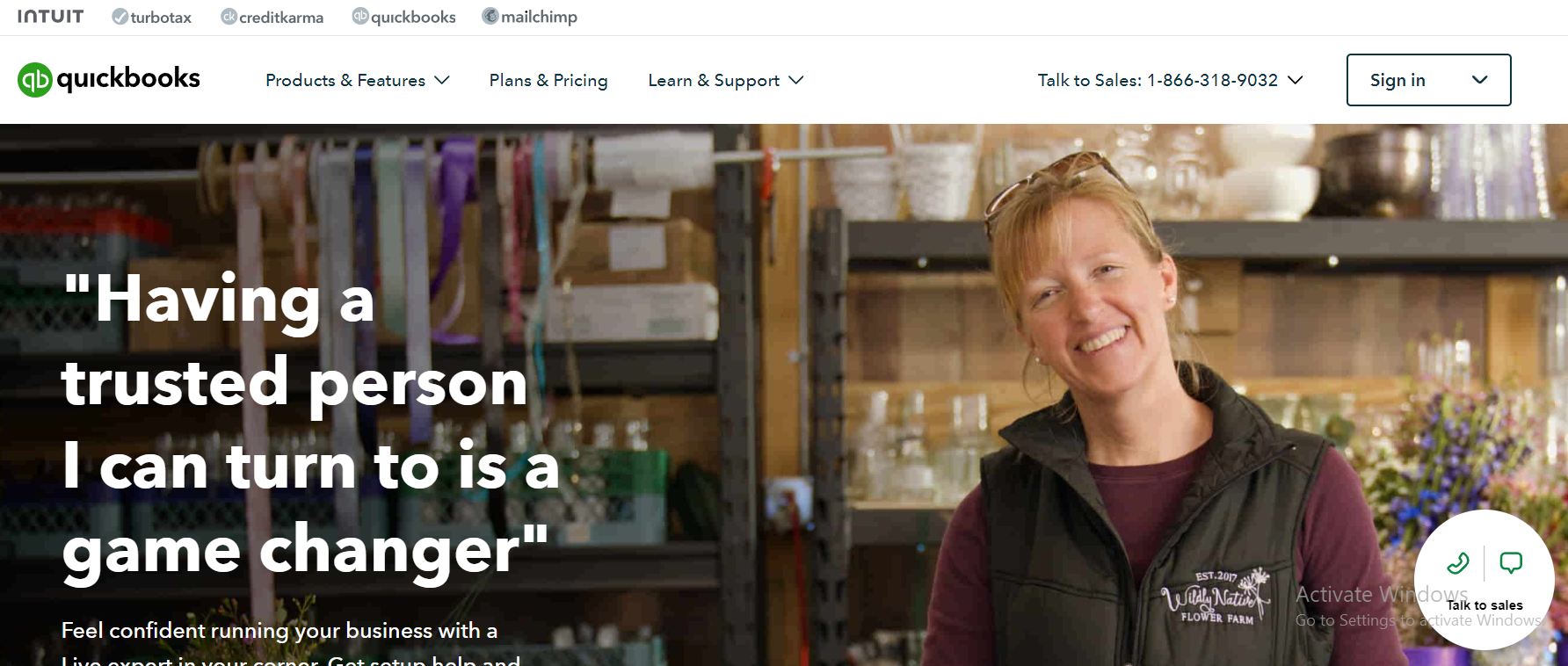
The last thing you want is to blow your budget on too many products before you’ve had time to figure out what works.
So, keep in mind that if you’re launching a general store, the costs can escalate quickly due to the need for multiple products and varied marketing campaigns.
On the other hand, a niche store with fewer, more targeted items can allow you to be more strategic with your budget.
2. Your Time Commitment
Managing 50+ products is a full-time job. Starting with 10–20 allows you to:
- Write quality product descriptions
- Create great visuals
- Run focused ad campaigns
Running a dropshipping business is time-consuming, especially when you’re managing too many products.
From my experience, focusing on a manageable number of products gives you the time you need to deliver quality in all aspects—from optimizing your product pages to running successful marketing efforts.
If you have limited time, I’d recommend launching with a curated selection of products. This approach allows you to learn the ropes without stretching yourself too thin.
Remember, starting with too few products is better than trying to manage a massive catalog and delivering poor customer service.
3. The Learning Curve
Start with 10–20 products to stay focused. Use AutoDS for automation, Copy.ai for faster descriptions, and Canva for polished visuals. Master your product pages, order fulfillment, and customer feedback early — without feeling overwhelmed!
One of the most important things to consider when deciding how many products to start with is the learning curve of running a dropshipping business.
When you’re just starting out, it can be overwhelming to juggle multiple tasks—finding the right suppliers, managing orders, creating effective marketing campaigns, and handling customer inquiries.
Trust me, I’ve been there, and trying to do it all with a massive product catalog will stretch you too thin.

Let’s say you’re using a tool like AutoDS. This platform helps automate a lot of the grunt work, such as product imports, price monitoring, and order fulfillment.
It’s a lifesaver for beginners because it simplifies processes that would normally take hours to manage. However, even with the help of AutoDS, there’s still a lot to learn about optimizing your store’s performance.
For example, you might find that it’s harder to create custom product descriptions, set competitive pricing, or troubleshoot customer service issues when you’re dealing with too many products.
So, starting with a smaller selection—around 10 to 20 products—gives you the breathing room to learn these essential tasks without being overwhelmed. You’ll be able to master how to:
- Optimize product pages for conversions.
- Handle order fulfillment efficiently.
- Gather customer feedback to improve product selection.
Moreover, you can use AI writing tools like Copy.ai or Jasper to speed up your product descriptions without making them sound robotic.
When it comes to visuals, don’t settle for supplier images. Use Canva to quickly create polished product mockups, banners, and promotional graphics. Also, if you want even higher-quality visuals, apps like Placeit offer easy templates for product displays and social media ads.
4. Your Business Model and Goal
Your business model will also influence how many products you should launch with. If you’re building a niche store, your product range might be limited, but highly specialized.
If you’re focused on a general store, you may need more products to meet customer needs across different categories.
For example, if you’re targeting fitness enthusiasts with a niche store, a small selection of high-quality products like resistance bands or dumbbells can help you focus on a specific target demographic.
On the other hand, if you’re testing the waters with a general store, you’ll want to consider a broader product range but start with a manageable amount, like 10 to 20 products.
5. The Best Number of Products To Start With (One Product, Niche, Or General Store?)
For faster testing, go with a general store (20–50 products). For long-term brand building, pick a niche (5–20 products). Find winning ideas using Google Trends and Minea.
Deciding whether to build a niche or general store depends heavily on your goals.
If you want fast results and flexibility, a general store (20–50 products across gadgets, home goods, pet accessories) gives you more testing opportunities.
But if you’re serious about building a brand that customers will recognize and love, go niche from day one.
Pick a specific category — like fitness gear, minimalist jewelry, or pet grooming tools — and curate 5–20 products that truly fit.
To find a profitable niche, you can use Google Trends to spot rising product categories and Minea to find trending products.
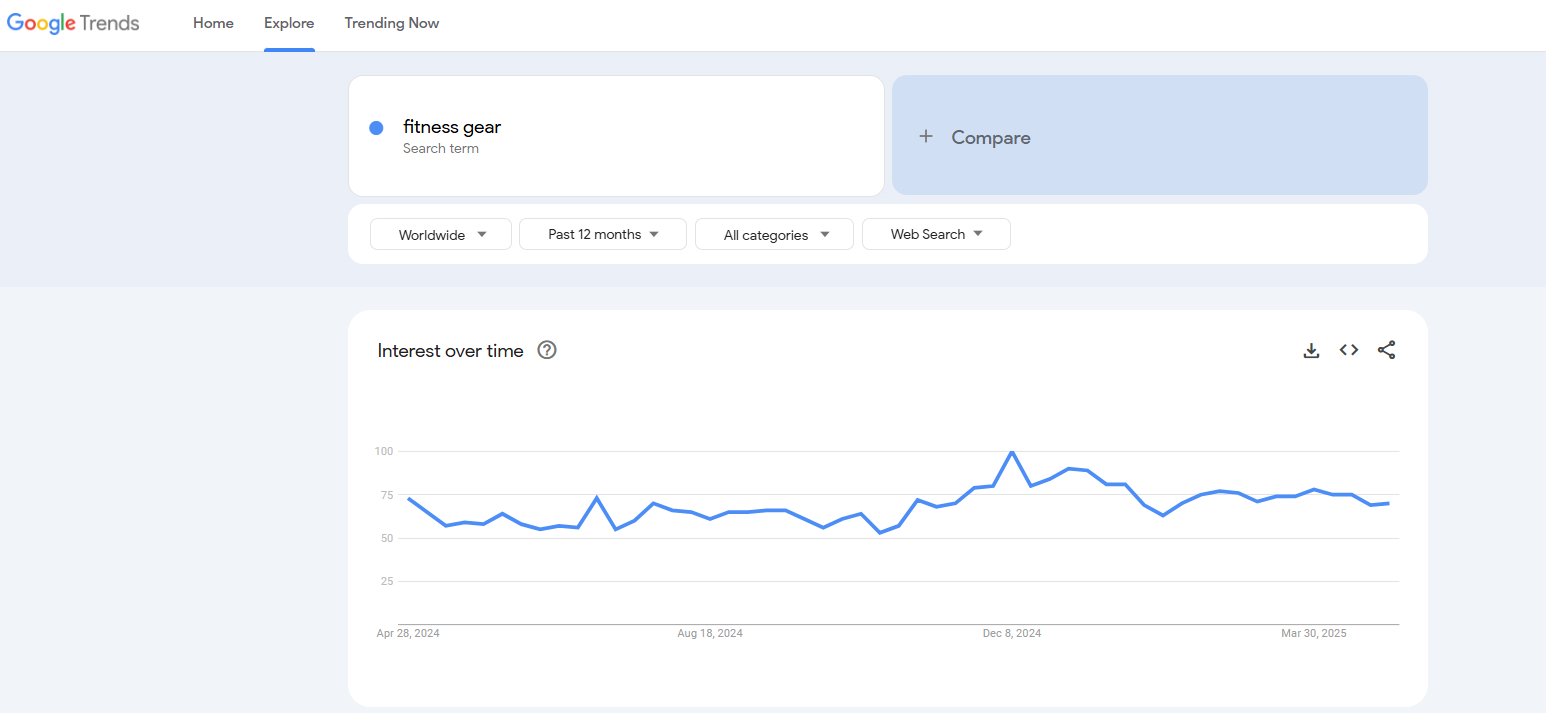
When you position yourself as a specialized store, it’s much easier to create authority, trust, and loyalty among your customers.
6. Meet Customer Expectations Today
Research with Google Trends and Meta Ad Library. General shoppers want more options. Niche shoppers want expertise. Deliver what they already expect — and watch your sales rise!
Today’s shoppers are smarter and pickier than ever, thanks to platforms like Shein, Temu, and Amazon.
They expect either variety (general shoppers) or expertise (niche shoppers).
You can use Google Trends to check what people are searching for in your category.
Pair that with a deep dive into the Meta Ad Library, where you can research what kinds of ads and offers competitors are showing — and how customers are engaging with them.
Moreover, I can get valuable insights about my target audience by using the Meta Ads Library. Here I can spy on my competitor’s ads and analyze their customers’ engagement, interest in products, sales, profits, etc.
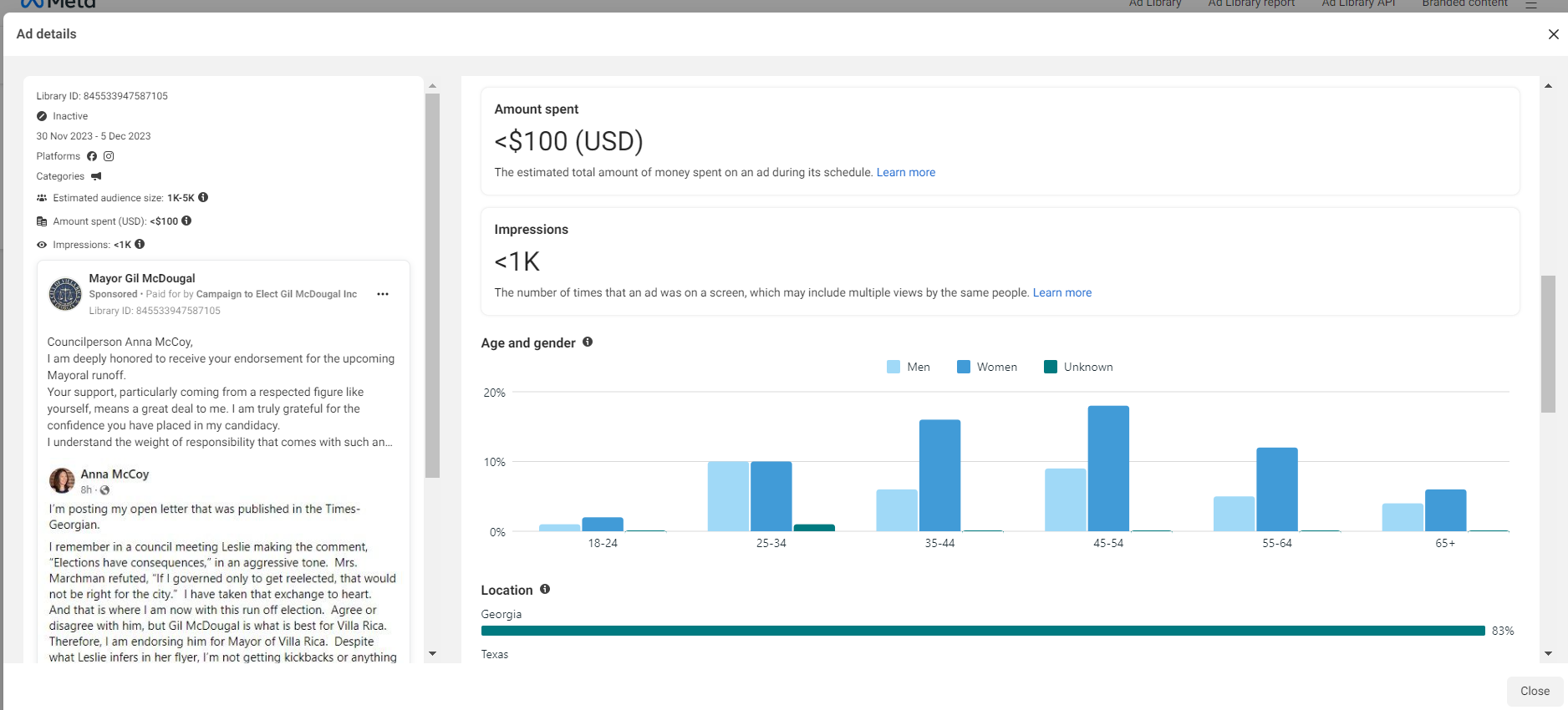
In my opinion, focusing on customer preferences early on will help you deliver the products your audience is searching for, rather than stocking up on items that won’t sell.
For example:
- If you’re seeing “variety stores” trending in home goods, you might want to offer a wider selection.
- If you’re seeing a spike in minimalist fitness products, you should focus on specialized collections that make you the “go-to” expert.
Understanding and delivering what customers already expect — instead of guessing — is one of the most powerful moves you can make in 2025.
7. Market Fewer Products Like a Pro
Create stunning ads using Canva. Schedule posts with Hootsuite. Focus on 5–10 winners instead of burning your budget on 30+ random products.
If you start lean with 5–10 great products, it’s much easier to build strong marketing campaigns.
Instead of spreading your ad budget thin, you can focus heavily on a few winners and make your brand look polished and irresistible.
Here’s how to do it smart:
- Use Canva to design scroll-stopping social media posts, product ads, and website visuals. They even have ready-made templates for Facebook, Instagram, TikTok ads, and email headers.
- Use Hootsuite (or Buffer) to schedule your posts in advance across platforms — Instagram, Facebook, Pinterest, and more.
- Create multiple ad creatives for one product instead of juggling 30+ random items. Test different headlines, images, and offers to find what resonates most with your audience.
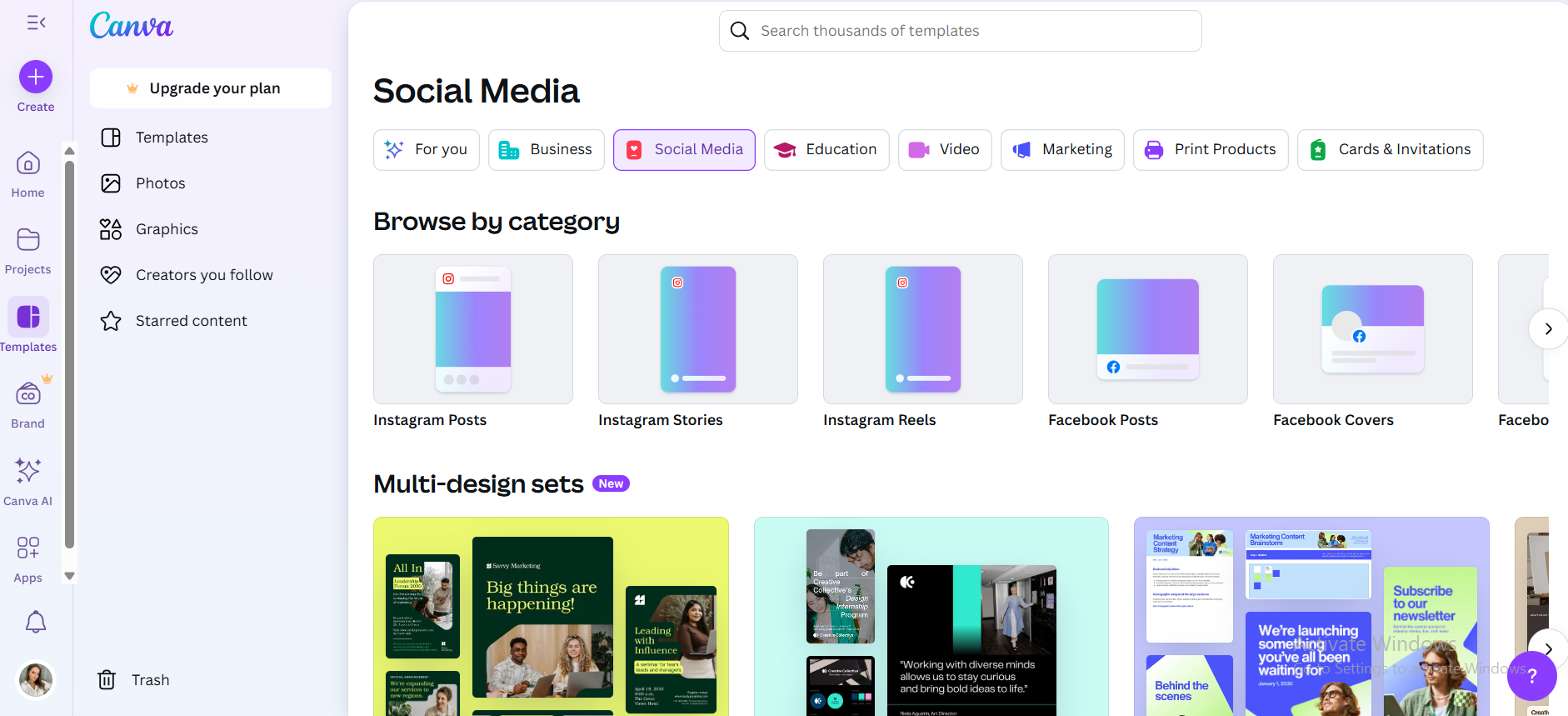
On the other hand, Hootsuite can really help you schedule social media campaigns, like Facebook ads, TikTok Ads, etc.
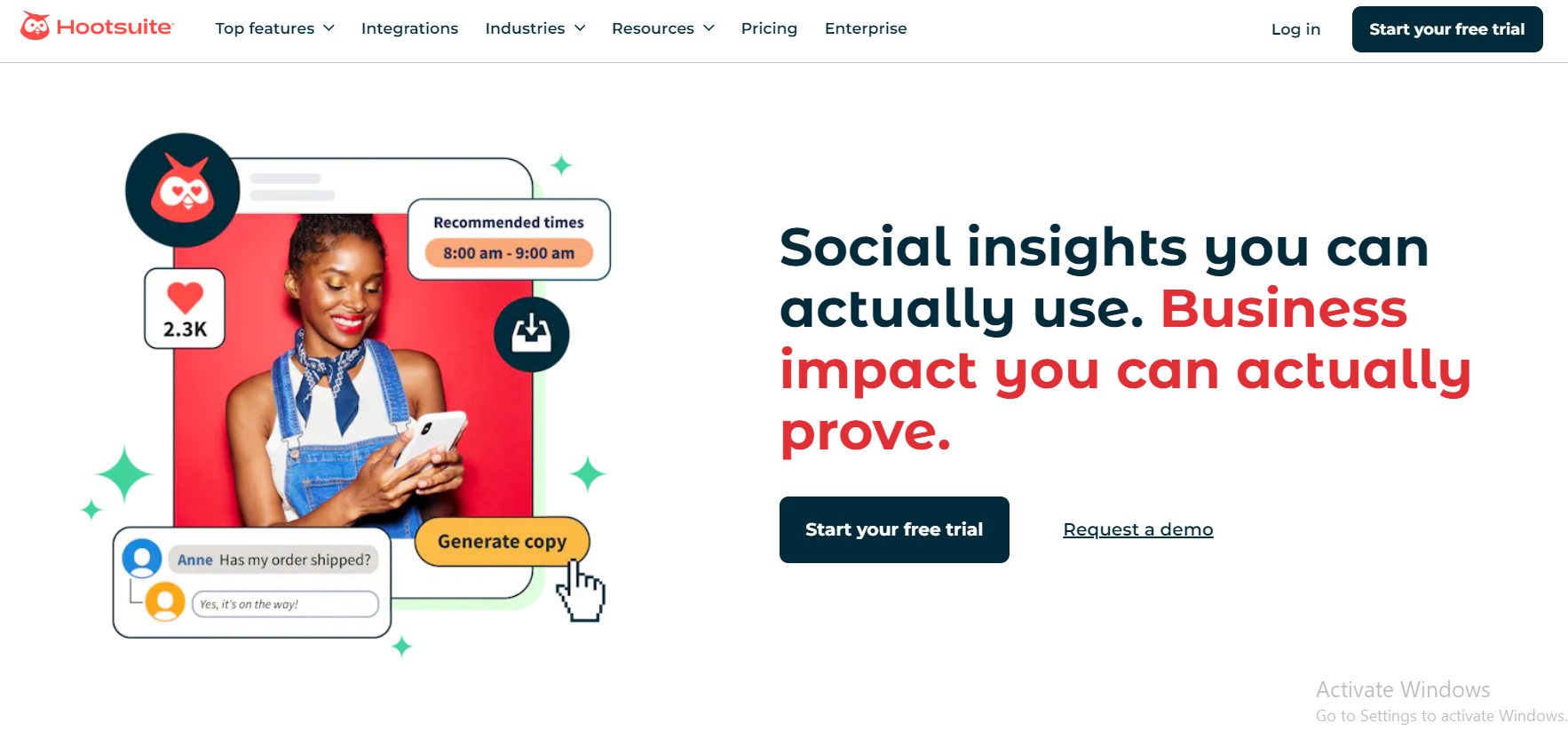
The goal? Dominate a small space first, then scale later once you have profitable data.
8. Manage Your Resources Wisely
Use ShipStation to streamline fulfillment. Start with fewer products and scale gradually based on sales data — not random guesses.
Managing your resources is another critical factor. When I first started, handling too many products became overwhelming—especially with fulfillment, inventory, and customer service.
That’s why I recommend starting small and using tools like ShipStation to streamline the fulfillment process.
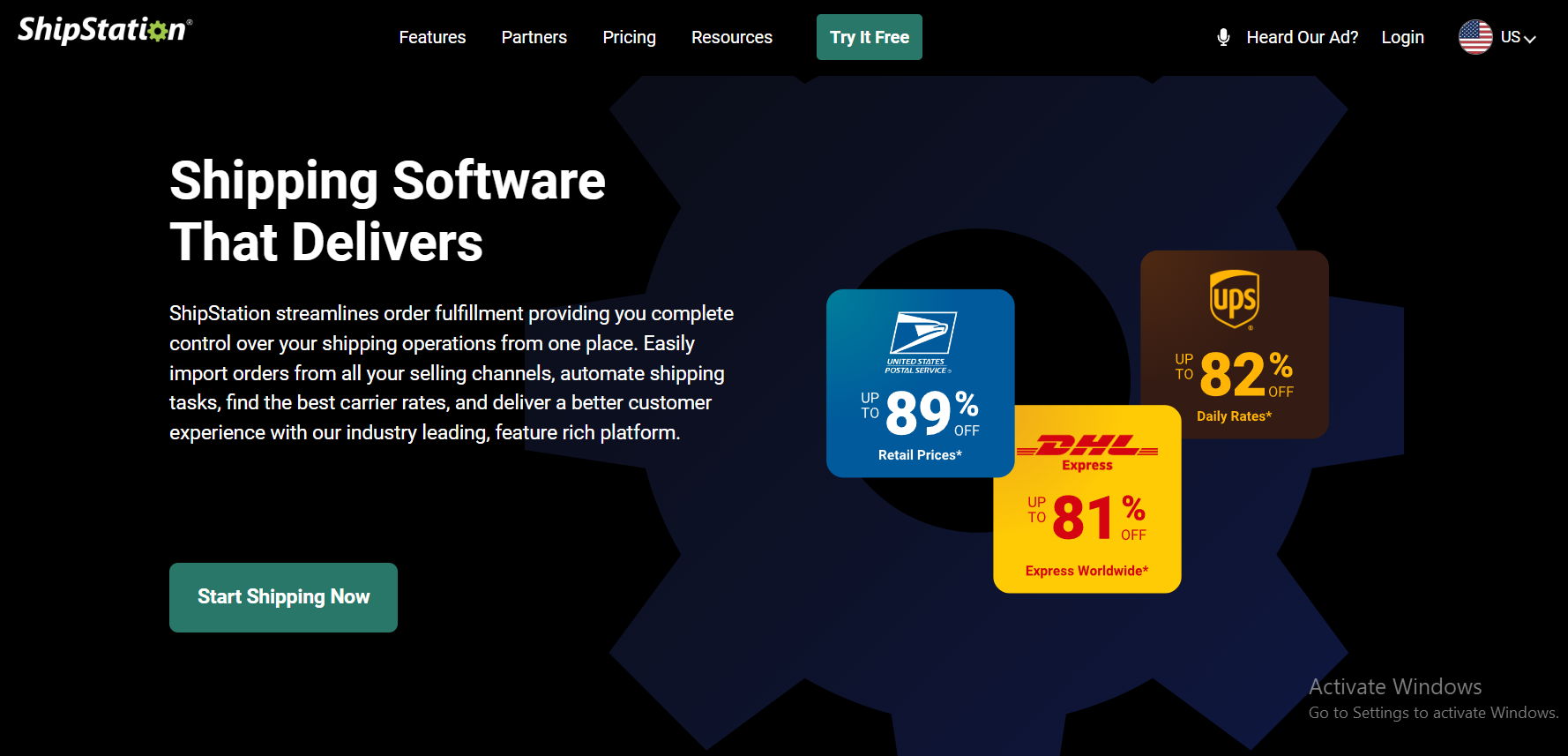
Over time, as your store grows, you can gradually expand your inventory and product selection based on what’s selling well and what your customers are asking for.
9. Use A/B Testing to Optimize Your Products
Run simple A/B tests with Optimizely. Experiment with product titles, prices, and images to find what converts best — while your catalog is still small!
Starting with a smaller product range also gives you the opportunity to fine-tune your listings through A/B testing.
This strategy allows you to test different elements of your product pages—like descriptions, pricing, and images—to see what performs best. For instance, you could test whether highlighting eco-friendly materials or offering limited-time discounts leads to more sales.
For example, with Optimizely, you can easily set up these tests and make data-driven decisions. With fewer products, it’s much easier to focus on optimizing each one.
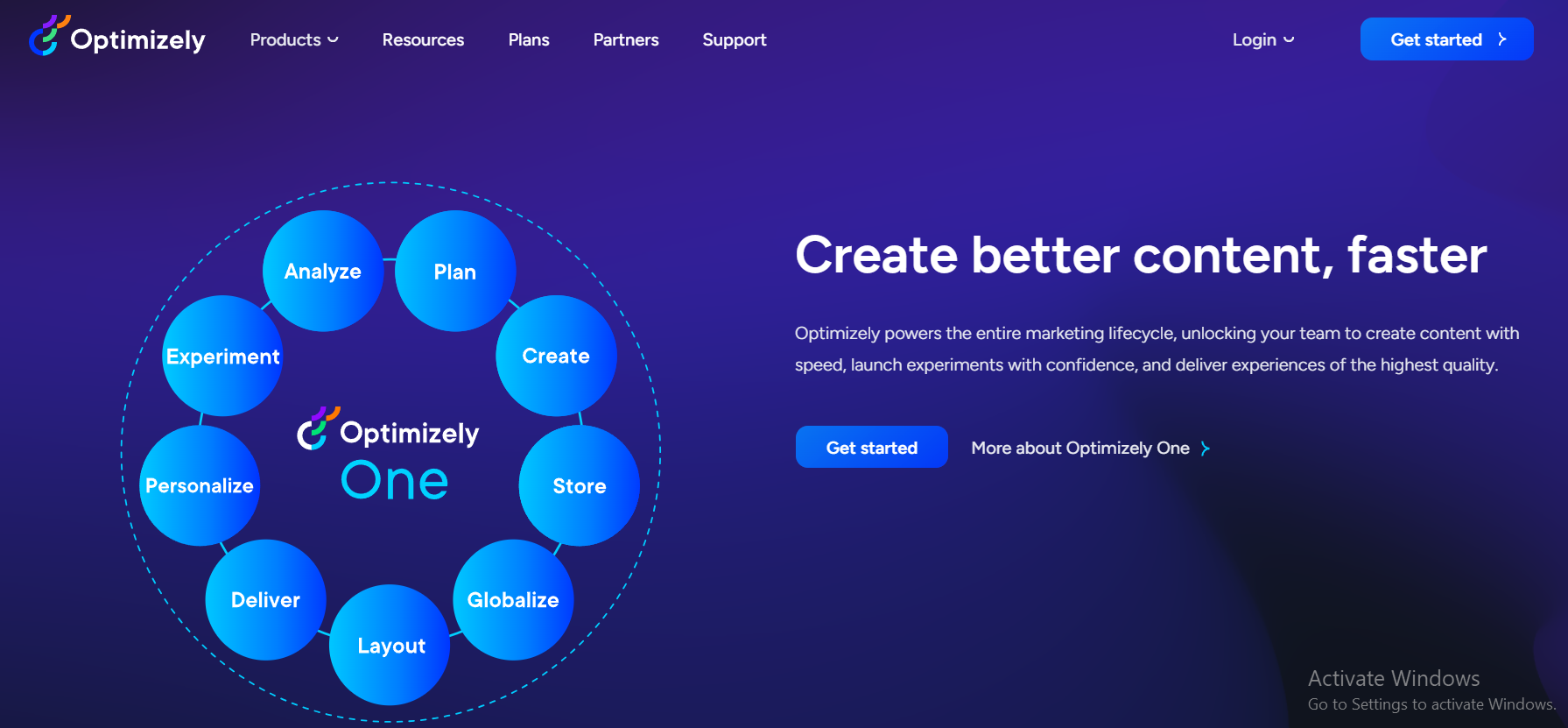
Running effective A/B tests can help you gather customer feedback and improve your conversions before you scale up.
10. Add New Items From Time To Time
Plan 1–3 new product launches every 4–6 weeks. Organize with Google Calendar and tease launches via Klaviyo email campaigns. Keep your store fresh and exciting!
Regularly adding new items to your dropshipping business can help keep your store fresh and engaging.
Start with a lean catalog, find out what wins, then add 1–3 new products every 4–6 weeks based on customer interest and seasonal trends.
For example, if you’re running a niche store that sells fitness gear, you could release new items like resistance bands or smart water bottles every month.
This keeps your product catalog exciting and allows you to see which new products perform well based on customer feedback.
Also, make sure to time these product drops around seasons or special events, like introducing outdoor fitness gear before summer.
Scaling isn’t about flooding your store with random products — it’s about strategic, timed expansions.
Here’s how to structure it:
- Winning Product List: Maintain a list of products that sell consistently.
- Launch Calendar: Set a recurring schedule using Google Calendar or Notion where you plan your next product drops.
- Email and Social Launches: Before launching new products, warm up your audience by teasing the new arrivals with sneak peeks and countdowns using Klaviyo for emails and Canva for teasers on social media.
- Data Tracking: Monitor your new launches with simple spreadsheets or tools like Shopify Analytics and Google Analytics to see which ones are sticking.
11. Avoid the “Paradox Of Choice”
Less is more! Curate your products like BlendJet — one amazing product line instead of 100 distractions. It’s easier to drive decisions and boost conversions.
You have probably experienced the paradox of choice. It doesn’t feel pleasant, right?
The variety of product options may sometimes produce tension and, eventually, a sense of sadness.
If you’ve ever bought something, you’ve encountered the paradox of choice. You stand in front of a shelf of clothes you don’t want to try on and wish there were only two shelves.
Just as the “Jam experiment” gives us a message, when there are fewer product options, more people make purchases. (30% of buyers purchased jam when there were 6 jam options 3% of the buyers purchased jam when there were 24 jam options)
Instead of being Amazon or AliExpress, and selling everything, maybe you should focus on curating your product list, select the ones that are the best options, and sell them!
For example, BlendJet is a dropshipping store that focuses on a single product – blenders, specifically the BlendJet 2 blender, perfect for whipping up smoothies and other tasty drinks.
Thus, the store has perfectly selected the products they sell, starting from their main BlendJet 2 blender to a few accessories related to the blender.
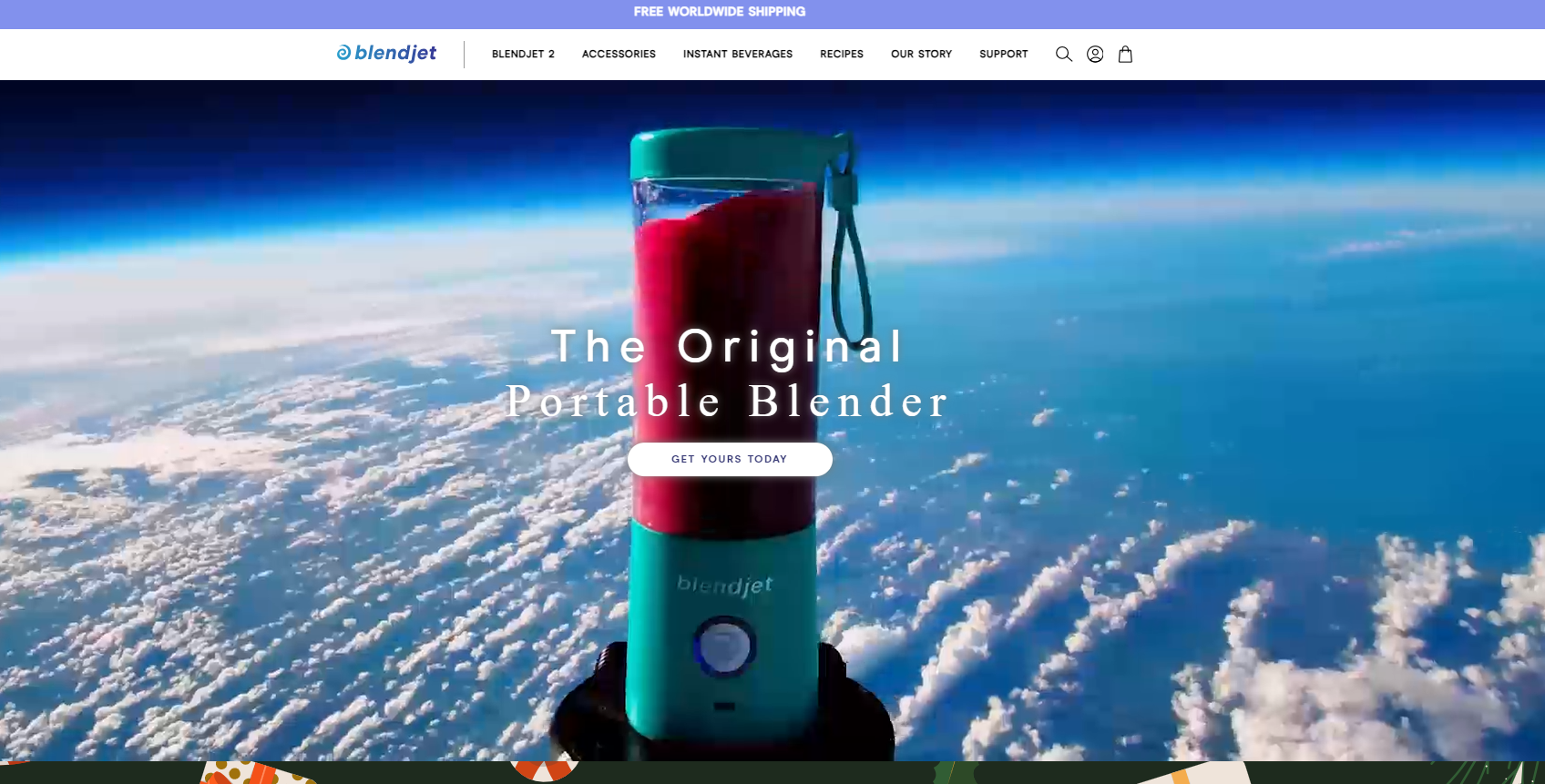
Just like many other dropshipping ventures, this started as a brilliant idea from a food blogger. Fast forward, and now it’s a thriving million-dollar dropshipping business.
How Many Products Should I Start With for a General Store?
🌟 Why Start With a General Dropshipping Store?
General stores let you test trends, sell any category, and adapt fast. Ideal for beginners who want flexibility instead of committing to one niche.
📦 How Many Products to Start? (20-50 products)
Start with 30–50 products. Less looks empty, more gets overwhelming. Spread them across 3–5 popular categories (Home, Beauty, Tech, etc.).
🎯 Best Product Types
- Trending + evergreen items
- Impulse buys (under $50)
- Problem-solving gadgets
🔥 Good picks: Smart home gadgets, kitchen tools, fitness gear, beauty products, pet accessories.
⚠️ Main Cons
- Harder to build brand loyalty
- Higher ad costs (broad targeting)
- Specialized stores feel more expert
- Lower repeat customers
Tip: Start broad. Niche down later based on bestsellers.
A general store doesn’t specialize in anything. It can sell everything from underwear to furniture, covering a wide range of product categories. Yes, that’s what a general store is!
Most dropshippers do this to follow trends. They promote items that are popular at the time and likely to sell well.
So, here’s the “big” dropshipping question: How many products should I start with when building a general store?
If you choose a general store for your dropshipping business, there’s really no limit. However, a good starting point is having between 20 to 50 products.
For example, imagine walking into a grocery store and finding only one shelf with 15 items, while the rest of the store is empty.
You’d probably leave with a negative impression and shop somewhere else. You might even wonder if the store is closing down or isn’t a real store at all.
If the number is less than 30, the shop will lack credibility in the eyes of potential consumers.
With a general store, you must ensure that you have enough items to give convenience to your dropshipping business. You should add additional goods in the future, but 30 to 50 products is a reasonable starting point.
However, I do not recommend a general shop if you want to build your personal brand. Hence, many people purchase the exact same products from other retailers before you even begin offering them. They are also more difficult to sell, and there is little room for branding.
To win with a general store, you want products that are:
- Trending but evergreen: Things people want now and will want tomorrow.
- Impulse-friendly: Products that make shoppers think, “Ooh, I NEED this!“
- Problem-solvers: Items that fix a little problem (or bring joy) instantly.
So, eBay might be a leader in the general store industry. Hence, the marketplace has almost all categories of products.
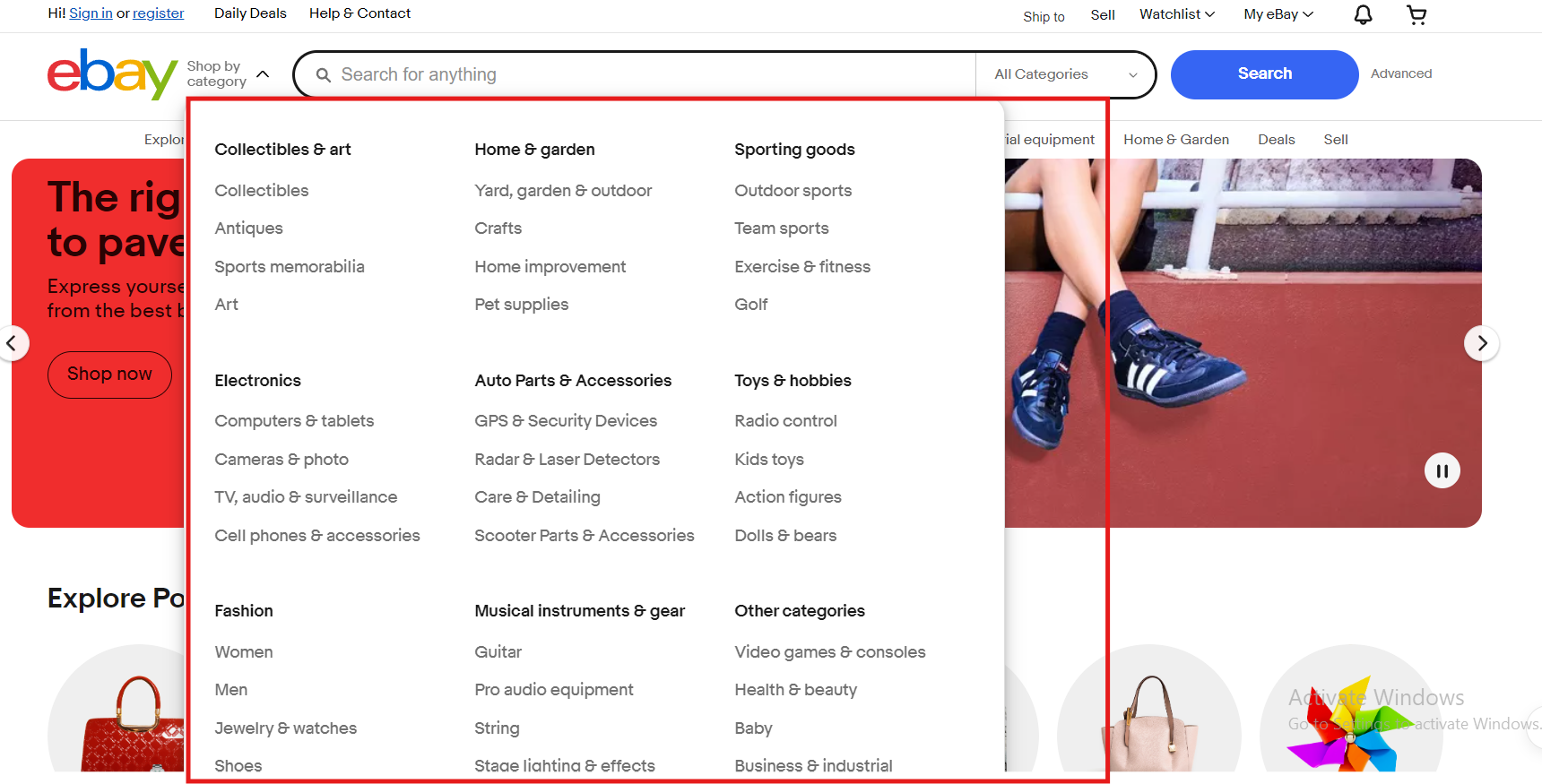
👉 Check out the Best 20+ Dropshipping Products For Valentines + How To Start.
So, here’s an example.
I always find Next Deal Shop inspirational when it comes to general dropshipping stores. Hence, they’ve been at it since March 2017, which is a good sign they’re doing something right. They’ve got a broad product range, but they seem to love home and garden stuff.
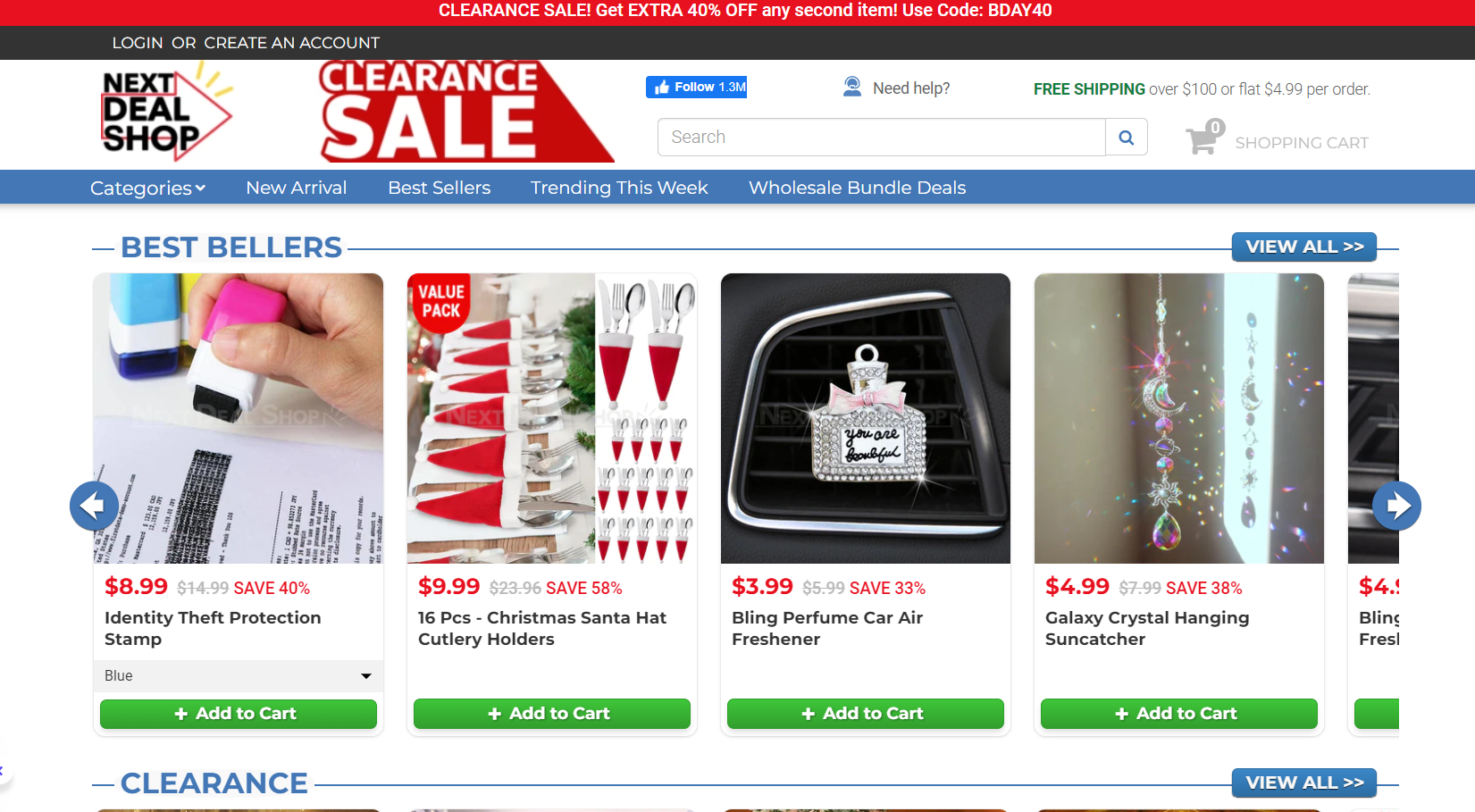
On the tech side, they’re using Shopify with their own fancy theme. It looks pretty cool. Take a peek at their products, and you might notice they resemble things from AliExpress. Also, they’ve got some nifty apps like PushOwl, Recover Lost Cart, and Product Reviews.
Guess what? They’ve got a whopping 1,500 products available. That’s a lot to choose from, huh? Overall, it’s a solid store with all the usual things you’d expect from a general store. The vibe and features will make you feel right at home. Definitely worth checking out!
Pros & Cons Of General Store Dropshipping
Pros of Dropshipping with a General Store:
✅ Diverse Product Range
General stores allow you to offer a wide variety of products, catering to different customer interests. So the question about how many products should i start with when dropshipping is most relevant here.
This flexibility of a wide range of products can attract a broader audience.
👉 Check out the Best Dropshipping Products In Any Niche For Max Profits.
✅ Market Trend Adaptability
With a general store, you can quickly adapt to changing market trends. This flexibility allows you to test various products and adjust your inventory based on demand.
✅ Exploration of Niche Markets
While it’s a general store, you have the opportunity to identify niche markets within your product range, allowing you to target specific customer segments.
👉 Check out the 15 Trending Kitchen Dropshipping Products To Sell Online.
✅ Lower Risk of Saturation
Since you’re not confined to a specific niche, the risk of market saturation is reduced. You can explore different product categories to find profitable opportunities.
✅ Testing Product
General stores are excellent for testing the viability of different products. You can assess customer response without committing to a specialized niche.
Cons of Dropshipping with a General Store:
❌ Lack of Expertise
Operating a general store may mean you lack in-depth knowledge about specific products or niches. This can impact your ability to provide expert advice or marketing tailored to a particular audience.
❌ Targeting Challenges
General stores might find it challenging to create targeted marketing strategies since the audience is diverse. Tailoring campaigns to suit everyone can be difficult.
❌ Brand Identity Issues
General stores may struggle to establish a strong and memorable brand identity. Specialized stores often find it easier to create a brand that resonates with a specific audience.
❌ Higher Advertising Costs
Since your audience is broad, advertising costs may be higher as you need to reach a larger and more diverse group of potential customers.
❌ Competition with Specialized Stores
General stores often compete with specialized stores that focus on specific niches. These specialized stores may have a more in-depth understanding of their audience, giving them a competitive edge.
🛒 Best Apps To Use For General Dropshipping Stores
If you’re running a general dropshipping store, having the right tools can save you time, boost your sales, and streamline your operations. Since you’re likely managing a wide variety of products across different categories, you need apps that are flexible, reliable, and easy to scale.
Here are the best apps to set up, manage, and grow a general store:
DSers — Store Setup & Management
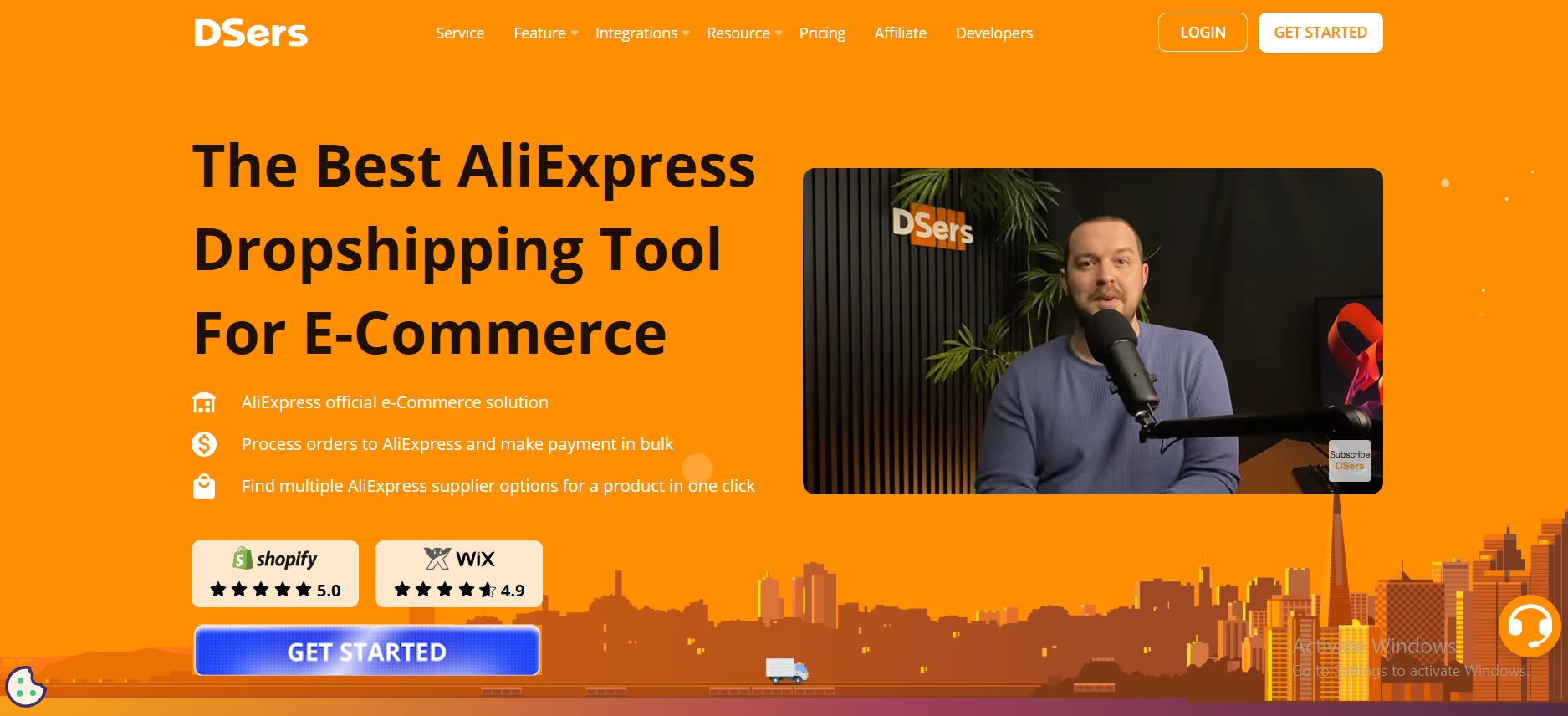
DSers is one of the best apps to automate and manage product imports, supplier orders, and inventory updates for a general store.
Built specifically for dropshipping businesses, it integrates perfectly with Shopify and lets you add multiple suppliers for one product, making it ideal when managing a wide range of items.
Key Features:
- Bulk order fulfillment in a few clicks
- Supplier optimization for better pricing
- Fast AliExpress integration
- Auto-updates inventory and pricing changes
Why It’s Good for a General Store:
When you’re selling 20–50+ products across different niches, managing suppliers manually is impossible. DSers makes it smooth, efficient, and scalable.
ShipStation — Logistics & Fulfillment

ShipStation simplifies your shipping workflow by integrating with major carriers like USPS, FedEx, UPS, and DHL. It’s a powerful app for fulfilling a large number of daily orders, offering discounted shipping rates and automation rules.
Key Features:
- Automated shipping label creation
- Real-time order tracking for customers
- Multi-channel fulfillment (Shopify, eBay, Amazon)
- Discounted carrier rates
Why It’s Good for a General Store:
General stores often deal with varied shipping requirements. ShipStation keeps your logistics organized, reduces mistakes, and speeds up delivery times — even when order volumes spike.
Klaviyo — Marketing & Customer Retention
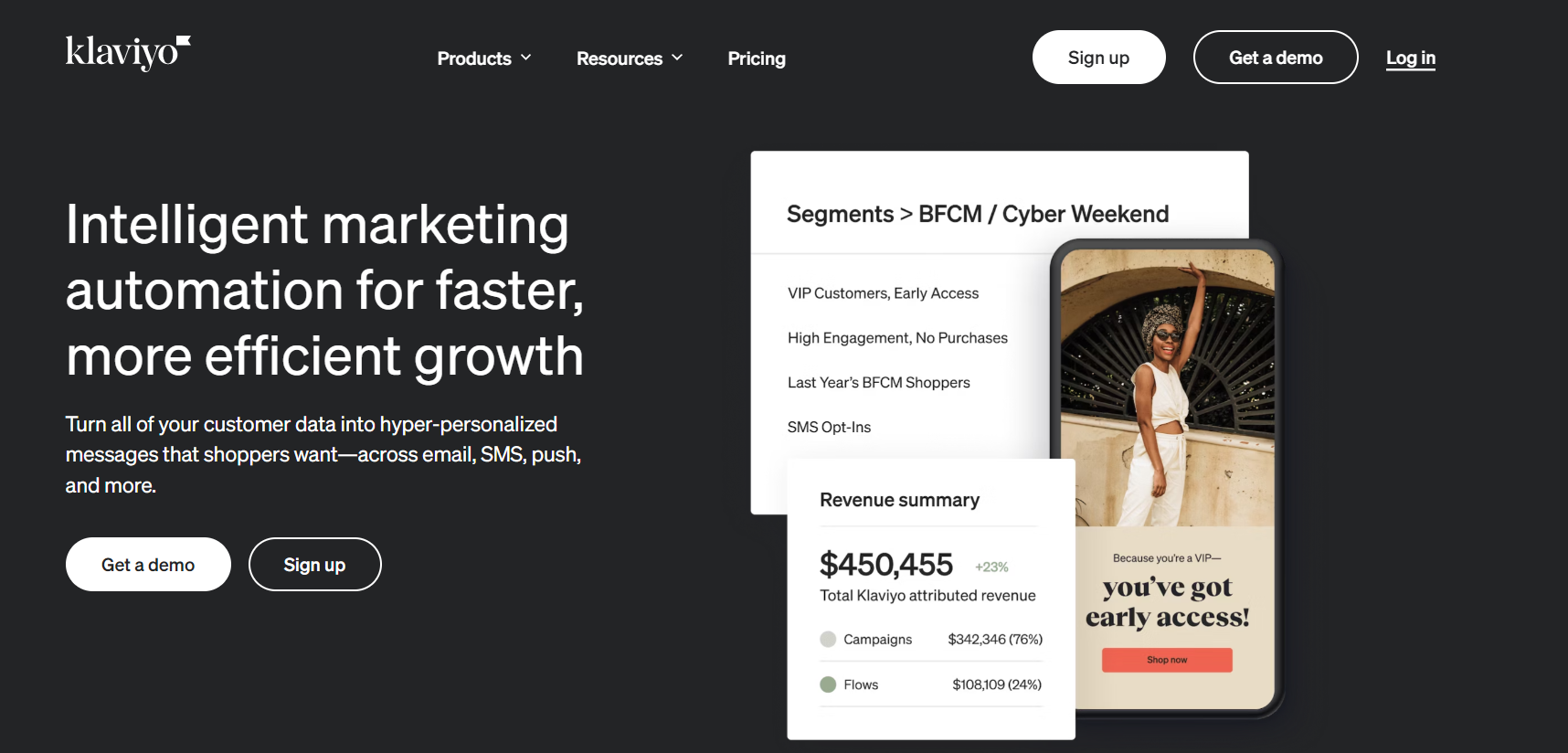
Klaviyo is a top choice for email and SMS marketing, especially for general stores that need to target different customer segments. With pre-built templates and powerful customer data tools, it helps you run personalized campaigns that drive repeat purchases.
Key Features:
- Advanced email & SMS automations
- Detailed customer segmentation
- Abandoned cart recovery flows
- Easy Shopify integration
Why It’s Good for a General Store:
Because you have customers interested in different categories, you can segment your audience and promote exactly what they want, leading to higher open rates, click-throughs, and conversions.
Top 5 Examples Of Successful General Dropshipping Stores
1. Oddity Mall
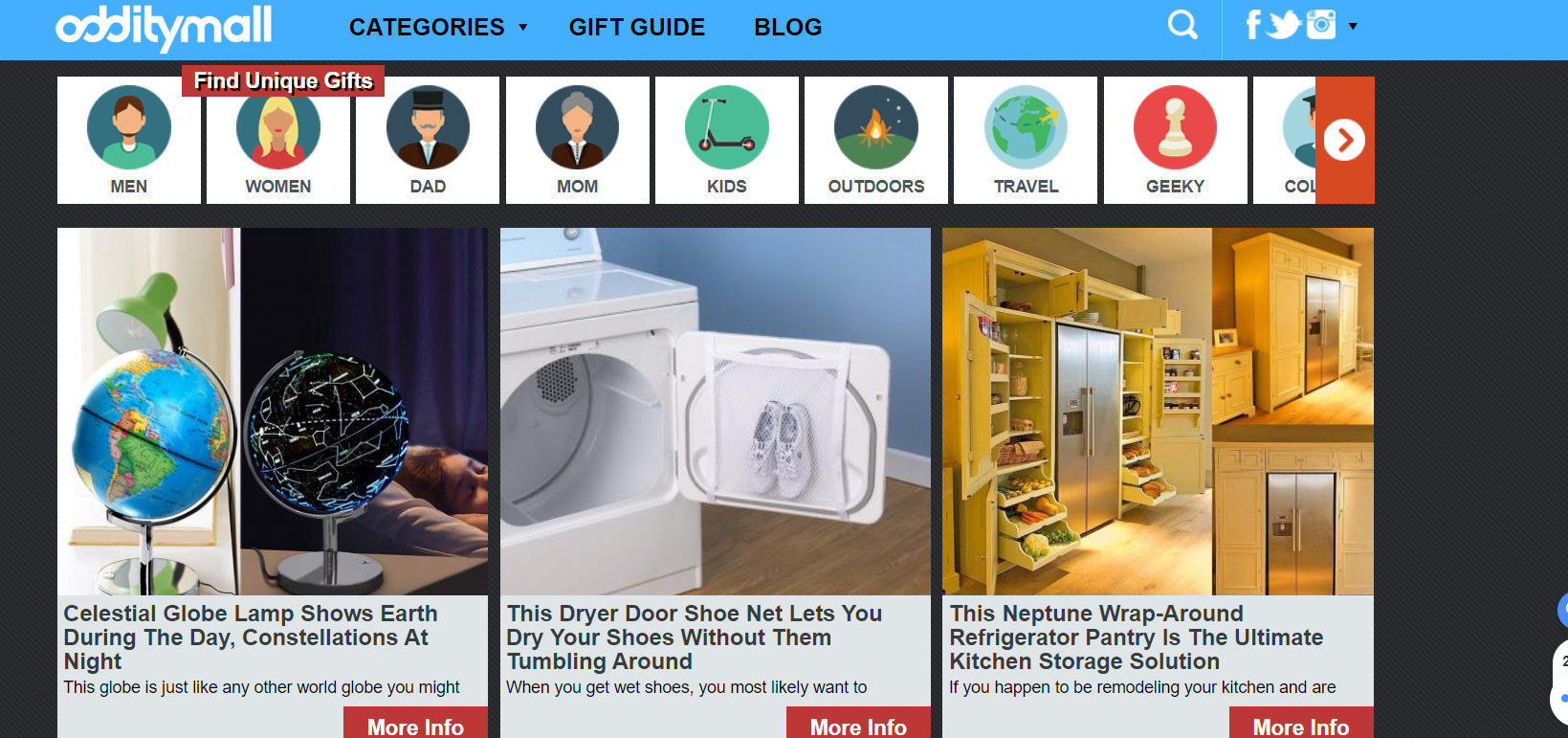
OddityMall stands out as a unique Shopify general dropshipping store, featuring a wide range of affordable products.
Rather than relying on aggressive marketing strategies, OddityMall focuses on offering a diverse selection of product categories, including gadgets, outdoor gear, geeky items, pet products, home and kitchen essentials, and kids’ goods.
The store’s success comes from its use of high-quality visuals, detailed product descriptions, and engaging videos.
These elements serve as the foundation of its sales approach, drawing in customers through visual and informational appeal.
2. Inspire Uplift
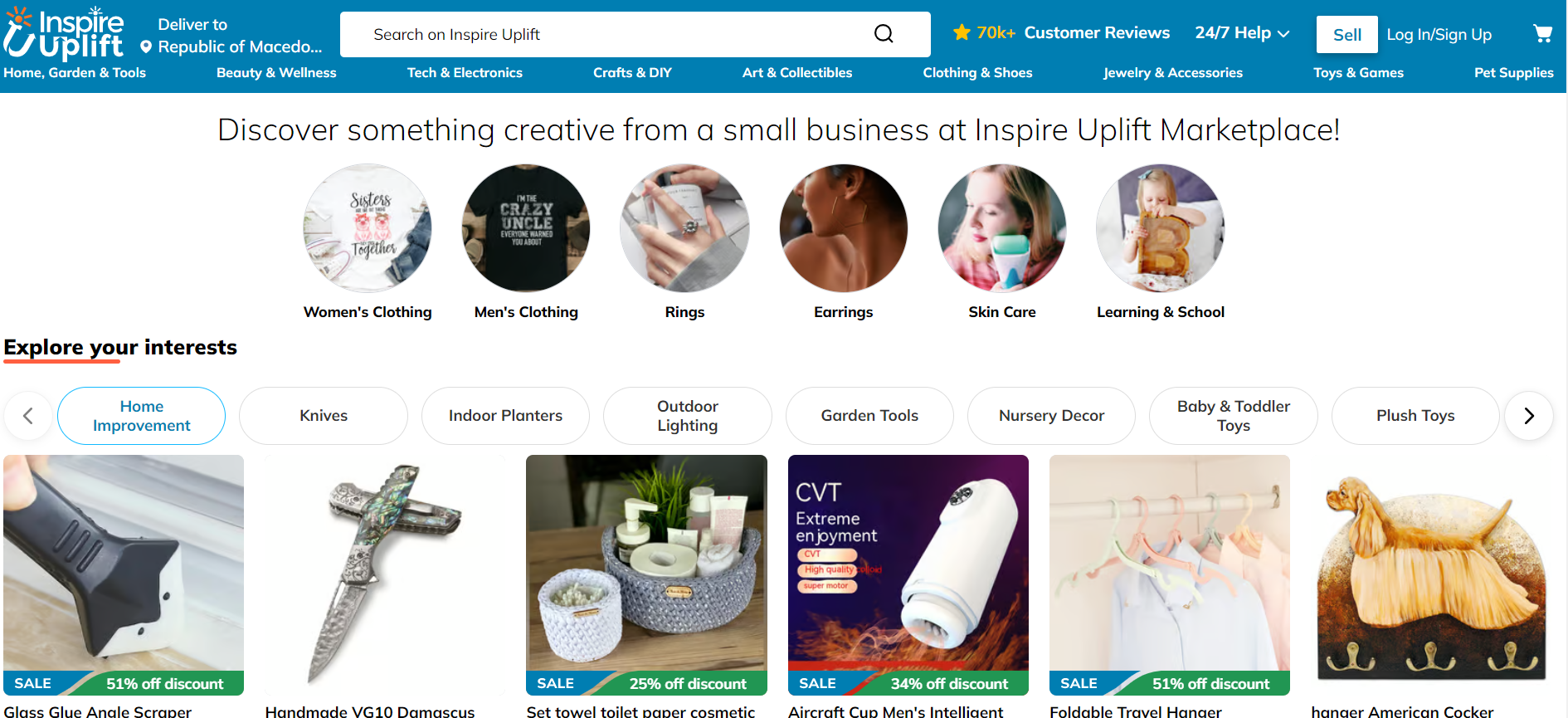
Inspire Uplift is a well-known general dropshipping store, offering a vast selection of fun, creative, and practical items at budget-friendly prices.
Their catalog includes products across numerous product categories, such as women’s clothing, men’s clothing, accessories, skincare, educational supplies, as well as indoor and outdoor products, making it a versatile destination for a wide audience.
3. Best Choice Products
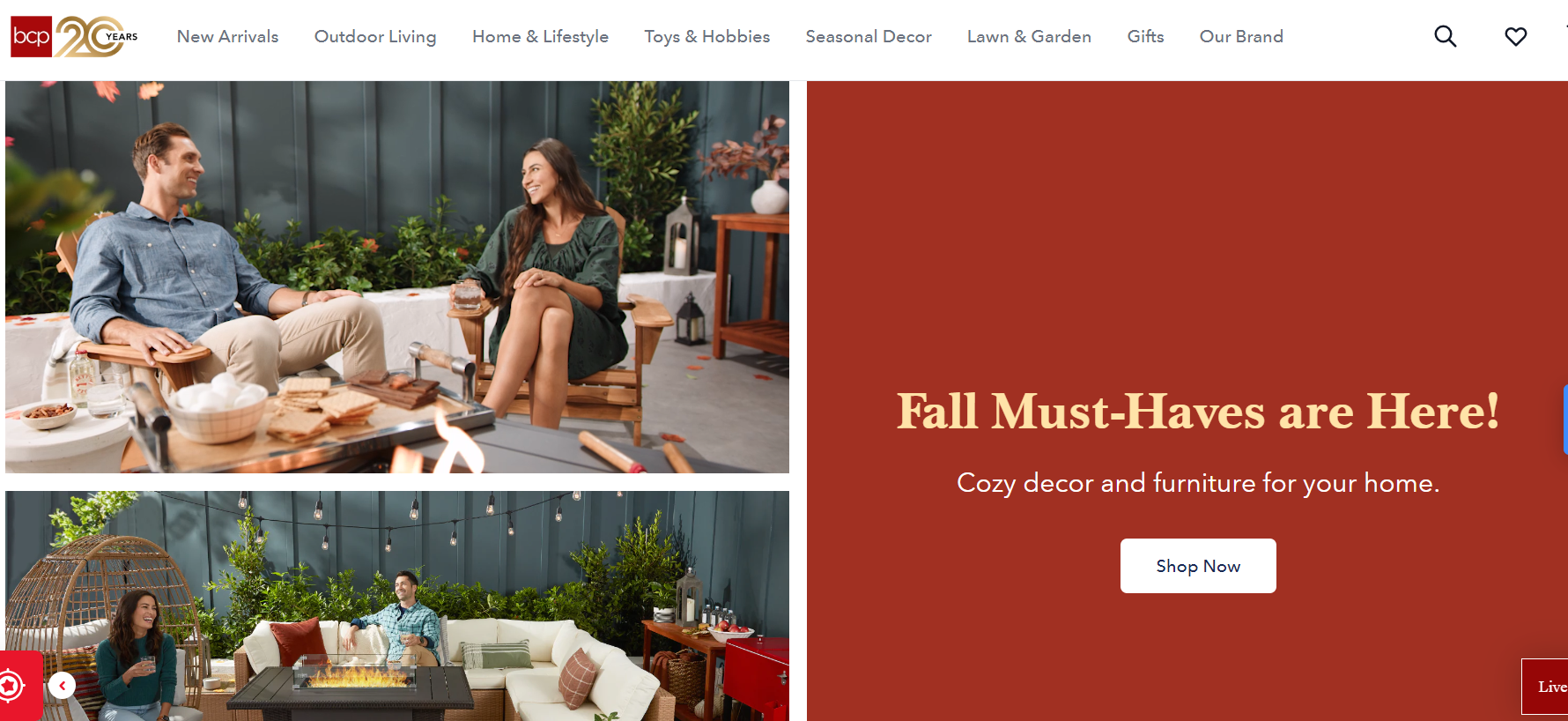
GreenLife Haven targets eco-conscious consumers by offering eco-friendly and sustainable goods.
With a focus on reusable household items and organic personal care products, the store taps into the rising demand for product categories that support a sustainable lifestyle.
4. Ergofinity
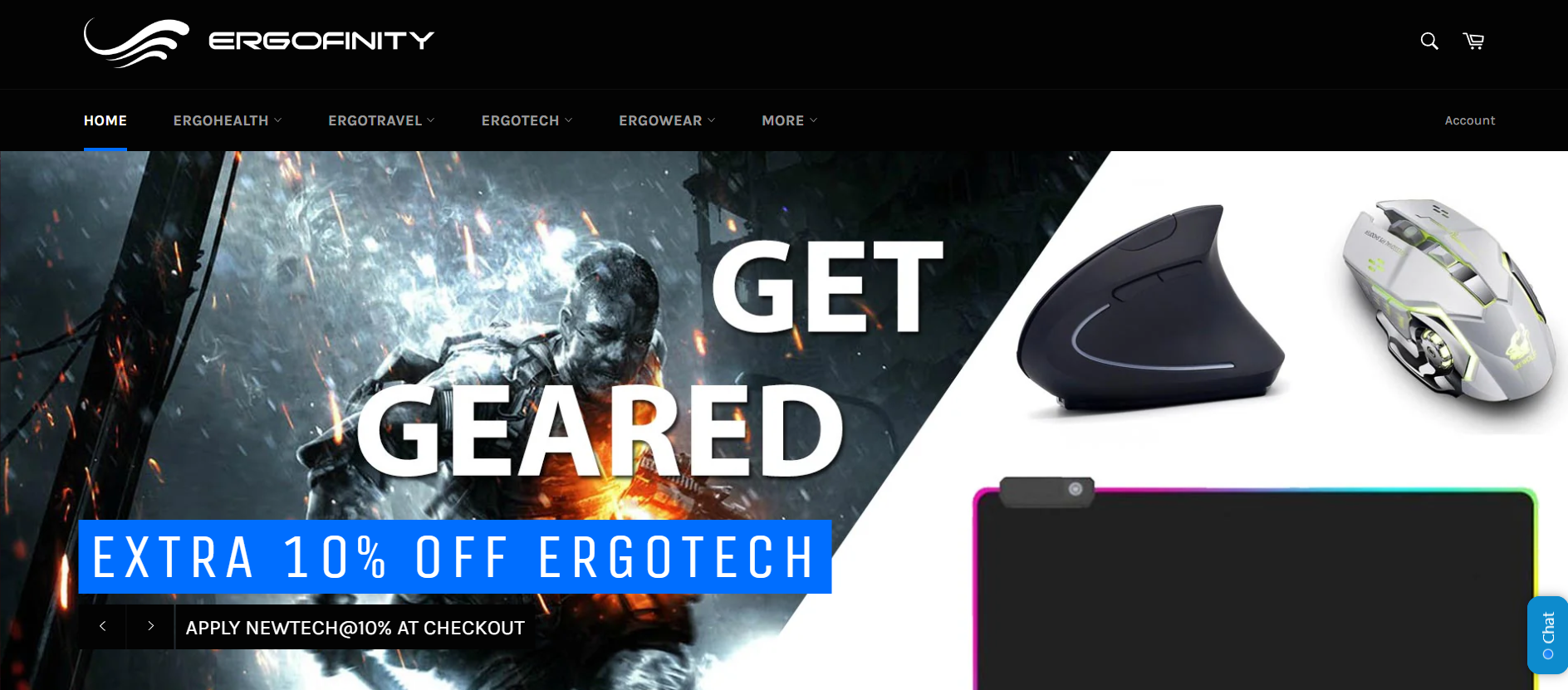
If you’re looking for a niche dropshipping store focused on ergonomic office products, you’ll want to check out Ergofinity. They offer a wide range of furniture, accessories, and gadgets specifically designed to maximize comfort and productivity in any workspace.
Right now, demand for home office solutions is booming, and Ergofinity has smartly positioned itself as a go-to brand for remote workers and office enthusiasts who want to upgrade their setup.
What’s clever about Ergofinity is how it educates customers instead of just selling products. Their digital marketing strategy includes blogs, infographics, and social media content that show why ergonomic setups matter — a smart move if you’re thinking about how to build trust and authority in your own store.
When you land on their site, you’ll notice a sleek, professional website design. Their product pages don’t just list features; they include detailed specs and practical tips for usage, which makes the shopping experience smoother and more informative. If you’re planning your own niche store, this is a great model to study.
5. Mrslm
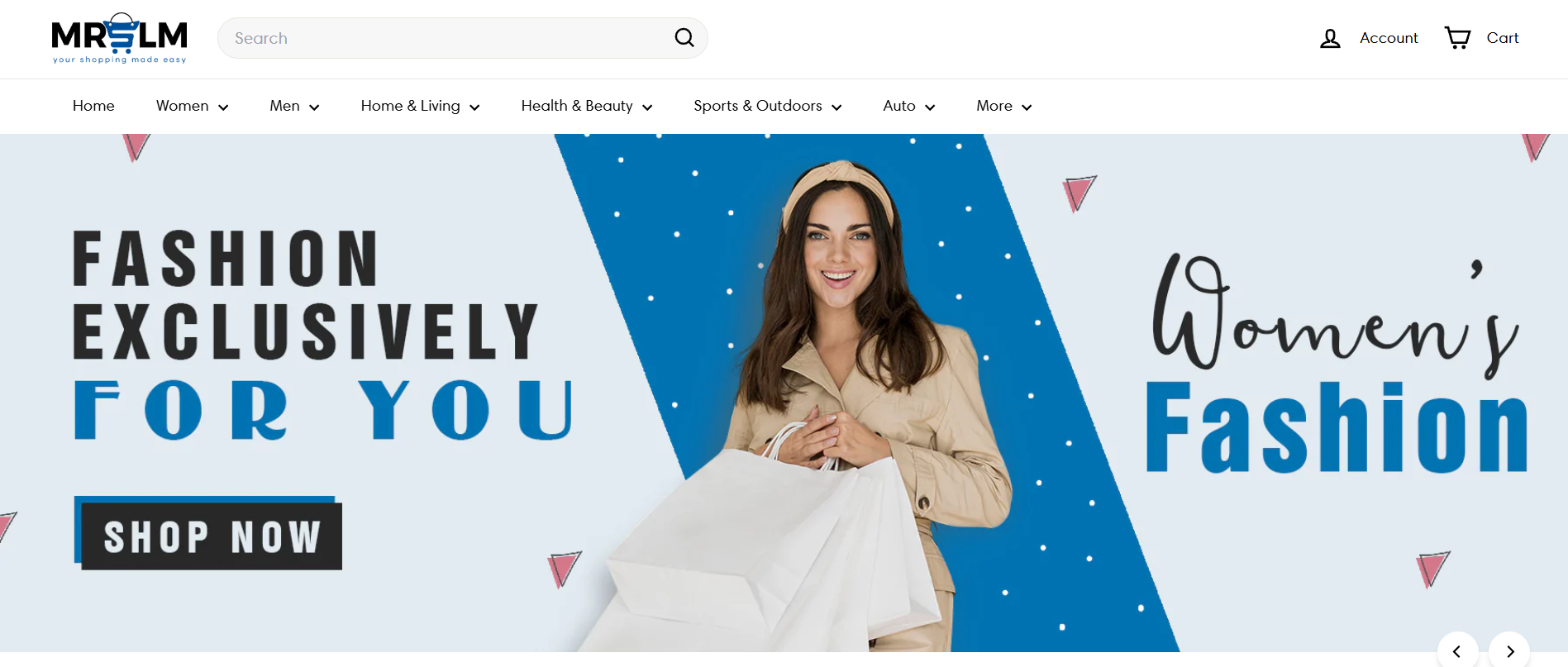
If you’re aiming for a broader niche but still want clear positioning, Mrslm shows how it’s done. They operate as a general dropshipping store but have carved out success in the fashion and beauty market.
You’ll find trendy clothing, stylish accessories, skincare products, and makeup — perfect for style-conscious shoppers hunting for affordable fashion. With competitive pricing, Mrslm attracts budget-savvy customers who still want to keep up with the latest looks.
Their marketing approach is heavily focused on social media influencers and targeted ads, which are highly effective strategies to boost visibility and drive fast product discovery — something to think about if you’re mapping out your advertising plan.
The website design is a visual treat, featuring bold colors and an interface that leads customers through an easy, enjoyable shopping experience. Every product page feels intentionally crafted to make browsing and buying feel natural. If you’re trying to create a high-converting general store, studying Mrslm’s flow and design choices could be a huge win.
How Many Products Should I Start With a Niche Store?
🎯 Why Start With a Niche Dropshipping Store?
Niche stores focus on a single category or audience. They’re ideal if you want to build a strong brand, target-specific buyers, and optimize for higher conversions.
📦 How Many Products to Start With In A Niche Store? (5-20 products)
Start with 5–20 products. Niche buyers expect depth, not bulk. Offer enough to show variety but keep it focused. For example, a swimwear store may need 10–20 styles, while a one-piece store needs fewer.
🔥 Best Product Types
- Specific to one audience
- High perceived value
- Style, hobby, or identity-based (e.g., yoga wear, minimalist jewelry)
✅ Pros
- Lower ad costs (narrow targeting)
- Build brand authority fast
- Better SEO and repeat buyers
- More loyal customer base
⚠️ Cons
- Limited product range
- Market shifts can hurt
- Requires deep niche research
- Harder to pivot once built
Tip: Choose a niche you know or love. Passion drives content, trust, and long-term growth.
Niche stores have a distinct marketing approach and are focused on a certain product, category, or brand
For example, if you want to target women of a specific age group, you may open a dropshipping store that solely sells fashionable women’s apparel
So, a reasonable starting point of product quantity here might be from 5 to 20.
Customers will comprehend a limited product selection better in a niche store than in a general store because people believe that if your business is focused on a specific product type, it delivers better quality and it appears more legit.
If you offer swimwear, you’ll probably need 10 to 20 distinct models to feel like you’ve covered the market properly.
However, with anything more particular, such as one-piece swimwear, you may offer fewer as there are fewer options. You only need enough in a specialty store to seem authentic to the ordinary internet consumer.
There are various examples of niche dropshipping stores on Shopify, like Warmly– a lighting niche store, Fashion Nova – women’s clothing, Taylor Stitch – men’s clothing, and many more.
Here’s an example.
Also, a great example is GymShark. It is a famous fitness clothing brand and a niche dropshipping store based in the United Kingdom. It’s recognized as one of the top players using the Shopify platform.

Thanks to a big social media following and customers spanning over 130 countries, GymShark has made a mark on the world stage. Nowadays, the GymShark website draws in over 9.6 million visitors every month.
And here’s the cool part about niche dropshipping stores – they make it simpler to connect with your target audience, boost conversions, and let you dive into something you genuinely enjoy, especially if you choose a niche that excites you.
Do you need help choosing a specific dropshipping niche? Or, maybe you need information on which one is most profitable?
Pros & Cons Of Niche Store Dropshipping
Pros of Dropshipping with a Niche Store:
✅ Targeted Audience
Niche stores focus on a specific market segment, allowing for a more targeted and personalized approach to marketing to your target demographic. This often leads to higher conversion rates.
✅ Expertise and Authority
Specializing in a particular niche allows you to showcase expertise and build authority in that specific industry. Customers may trust your store more for niche-related products.
✅ Efficient Marketing
Niche stores can tailor marketing efforts to a well-defined audience, making campaigns more efficient and cost-effective. You can speak directly to the needs and interests of your target customers.
✅ Lower Advertising Costs
Targeted marketing often results in lower advertising costs.
You can reach a more engaged audience, reducing the need for broad and expensive advertising campaigns.
✅ Brand Recognition
Niche stores can establish a strong and memorable brand identity within a specific market, making it easier for customers to remember and recommend your store.
So, when it comes to how many products should i start with when dropshipping in a niche store, I rather emphasize building a brand with a few first.
Cons of Dropshipping with a Niche Store:
❌ Limited Product Range
A niche store might have a more limited product range compared to a general store. This could potentially limit the number of customers and revenue streams.
❌ Market Volatility
Niche markets can be more susceptible to economic fluctuations or trends. If your niche falls out of favor, it may impact your sales more significantly than a diversified general store.
❌ Initial Market Research
Setting up a niche store requires thorough market research to identify a profitable and sustainable niche. This research can be time-consuming and may not guarantee success.
❌ Competition with Established Brands
Niche markets often have established competitors. It can be challenging to compete with existing brands that have a strong foothold in the niche.
❌ Diversification Risks
Relying solely on a niche means higher dependence on the success of that specific market. If the niche becomes less popular or faces challenges, your business may be at risk.
Best Apps To Use For Niche Dropshipping Stores
Running a niche store means being laser-focused on a specific audience. Your app choices should make your brand feel polished, help you maximize customer loyalty, and streamline product management without overwhelming you.
Here are the best apps for a niche dropshipping store:
Zendrop — Store Setup & Management

Zendrop is an all-in-one dropshipping platform that provides faster shipping, branded product options, and an easier experience for niche-focused stores.
Key Features:
- Private labeling & custom packaging options
- US-based warehouses for faster delivery
- Easy product import from curated catalogs
- Auto fulfillment options
Why It’s Good for a Niche Store:
If you want to build a real brand around a tight product catalog, Zendrop lets you focus on quality and brand feel instead of worrying about cheap overseas suppliers.
Easyship — Logistics & Fulfillment
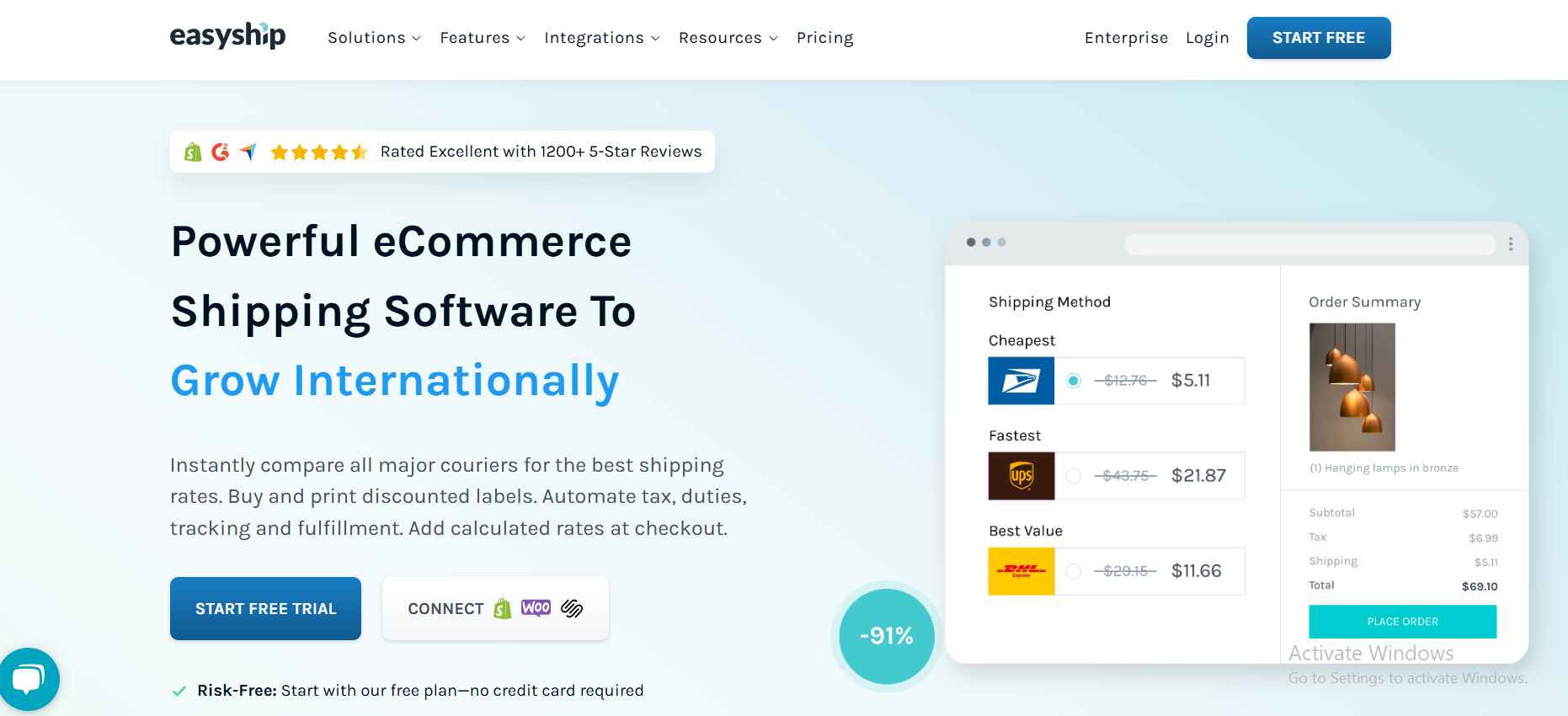
Easyship helps niche dropshipping stores offer flexible, affordable shipping options worldwide. It automates the complex shipping process and gives you access to multiple couriers with pre-negotiated rates.
Key Features:
- 250+ shipping solutions globally
- Dynamic checkout showing real-time shipping options
- Tax and duty calculations upfront
- Customizable tracking pages
Why It’s Good for a Niche Store:
Niche customers expect premium service. Easyship helps you provide fast, transparent shipping no matter where your customer is, building more trust and better brand perception.
Postscript — SMS Marketing for Niche Audiences

Postscript is an SMS marketing platform that helps niche stores build direct, personal connections with their customers through texts.
Key Features:
- Targeted SMS campaigns
- Abandoned cart recovery via SMS
- Customizable automations based on behavior
- Shopify-native integration
Why It’s Good for a Niche Store:
Niche customers appreciate personal engagement. SMS marketing feels immediate and personal, giving you better conversion rates and customer loyalty.
Top 5 Examples Of Successful Niche Dropshipping Stores
1. Unconditional
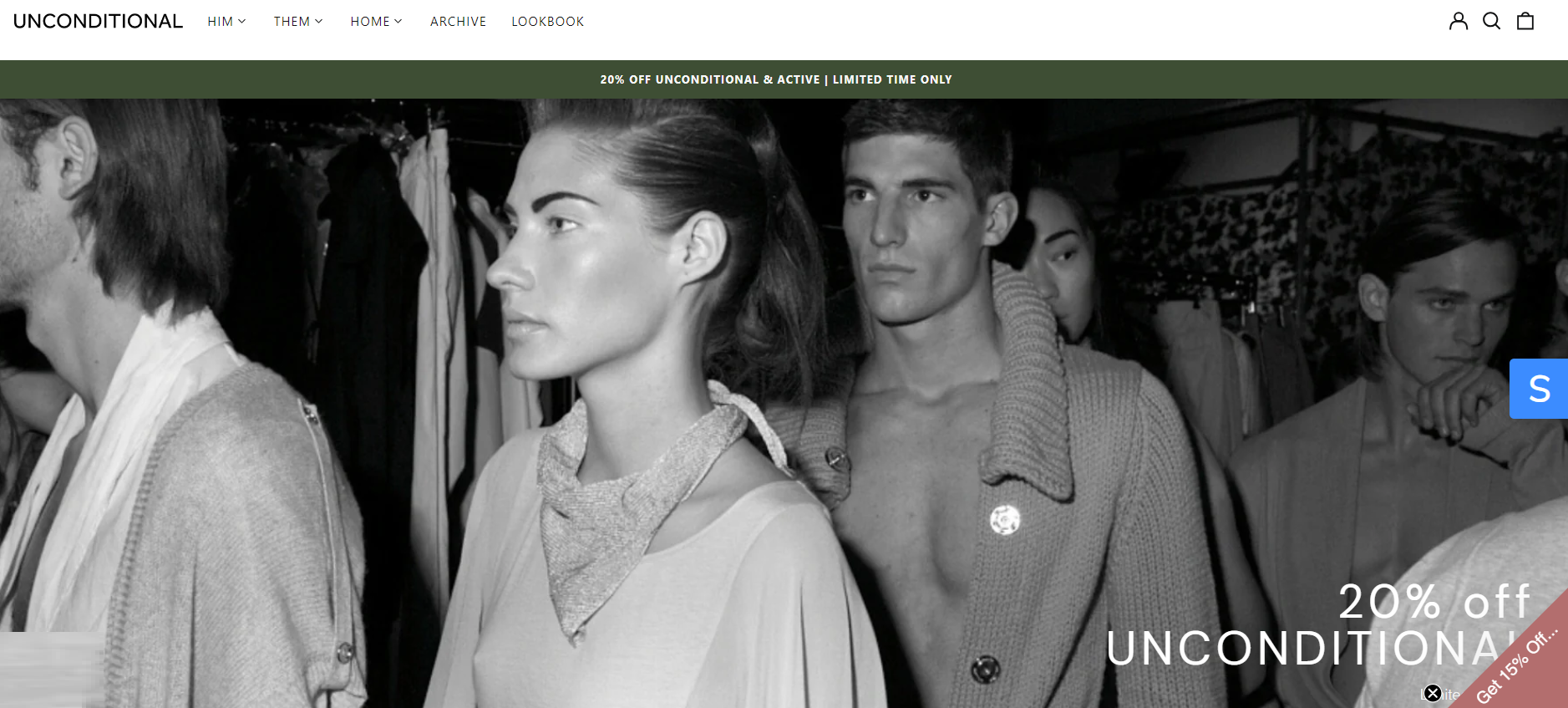
Unconditional is a standout Shopify store that’s been in the premium clothing industry for over a decade.
Their site design immediately sets the tone with a classic and minimalist feel, giving it a high-end appeal.
With engaging pop-ups for newsletters and sleek full-screen photo layouts, they manage to balance aesthetics with functionality.
Their product pages provide all the necessary details, including size guides and photos, while cross-selling with the “You may also like” feature.
The use of social proof through a detailed footer strengthens trust, and their marketing strategy ties in well with newsletters and a strong social media presence.
2. Notebook Therapy
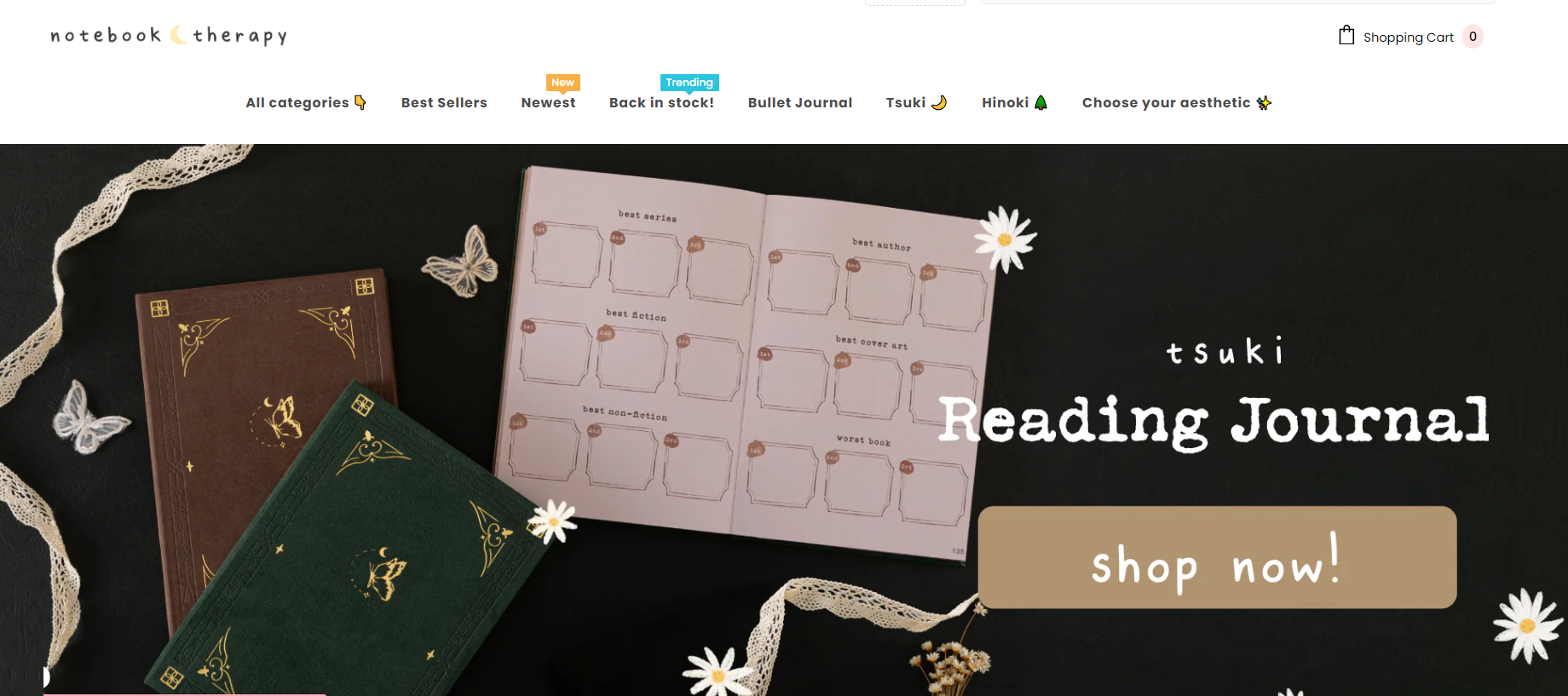
Notebook Therapy specializes in Japanese and Korean stationery, targeting an Eastern-culture-inspired audience.
The website is visually engaging, immediately offering value through a $50 gift card pop-up.
This Shopify store excels in user experience, with a full-screen photo layout and well-placed call-to-action buttons like “Shop Now,” enhancing conversions.
Its navigation is simple but effective, while product pages feature detailed descriptions and high-quality photos.
3. My Luxurious Home
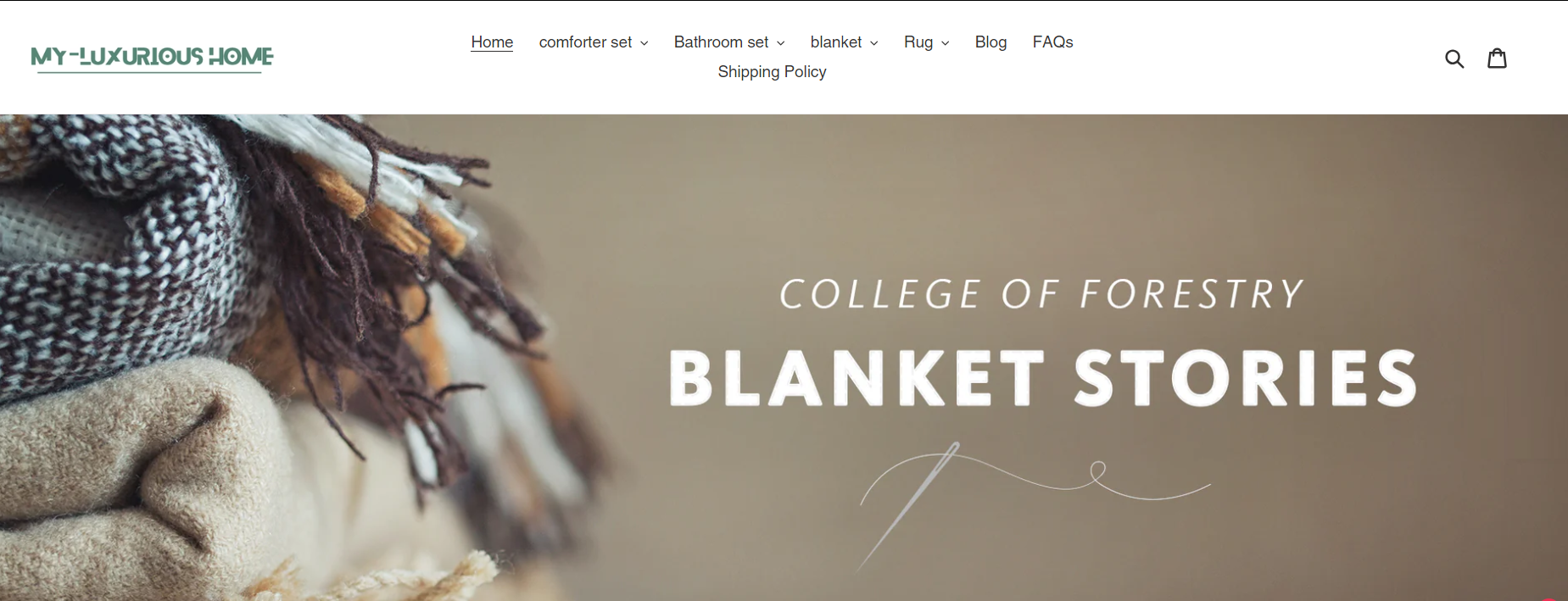
My Luxurious Home is another strong Shopify store, focusing on home goods such as shower curtains and bed sets.
They offer a broad selection of affordable, high-quality products shipped globally via well-known logistics companies like DHL and UPS. The website’s design is visually appealing with its full-screen photos and strategically placed call-to-action buttons in bold red.
Their product pages are detailed, including customer reviews that add trust. Marketing efforts include offering significant discounts and featuring a newsletter to inform customers about promotions.
The only drawback is the absence of visible social media links, despite having a presence.
4. Notebook Therapy
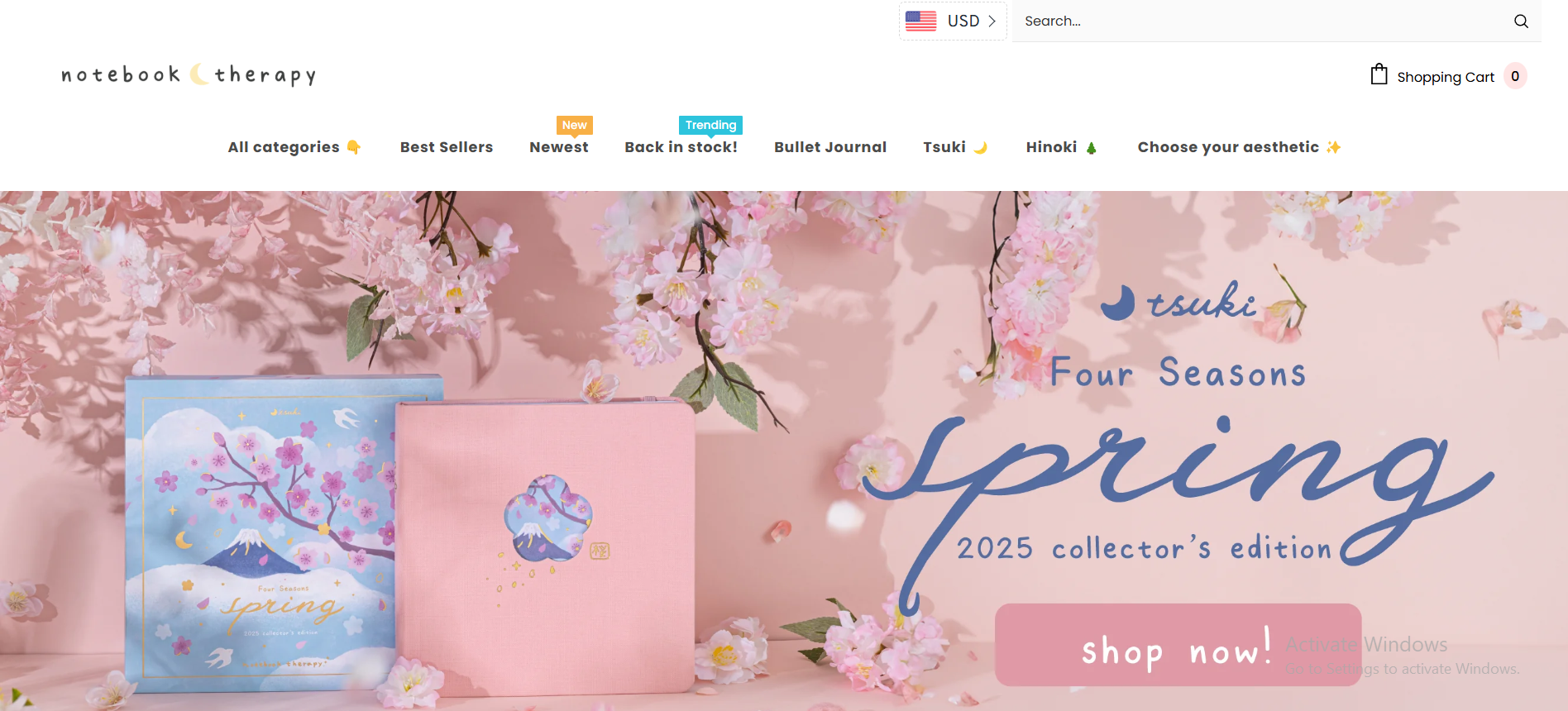
If you’re searching for aesthetic inspiration in the stationery niche, look no further than Notebook Therapy. This Shopify store thrives by focusing on Japanese and Korean-inspired journals, planners, and accessories, offering a stunning visual experience that captures its niche perfectly.
Right from the homepage, you’re welcomed with a full-screen seasonal banner, soft pastel tones, and delicate fonts that elevate the brand’s identity. The navigation is simple, directing users to top categories like Bullet Journals, Washi Tape, and more, while a “Shop Now” CTA keeps the customer journey seamless.
Their product pages are standouts—featuring high-res images, close-up visuals, and detailed product descriptions. Small design touches like handwritten text overlays and product comparisons add warmth and charm. Notably, Trustpilot reviews are embedded for credibility and upsell widgets promote related products.
Some of their bestsellers include the Tsuki Four Seasons Bullet Journals, Luxury Bullet Journal Sets, and Japanese Calligraphy Brush Pens, all of which cater to a loyal audience of creators and students.
Their marketing is content-driven: they promote their 1M+ Instagram followers, offer exclusive email discounts, and publish free templates and guides via a blog to boost SEO and community engagement.
With apps like Loox for reviews, Klaviyo for email marketing, and SEOAnt for SEO optimization, Notebook Therapy proves that a blend of strong branding, engaging content, and smart tech tools can make a Shopify store thrive.
5. My Luxurious Home

For dropshippers targeting the home décor and bedding market, My Luxurious Home is a top Shopify store to study. They specialize in elegant comforter sets, rugs, and bathroom accessories, blending affordable luxury with cozy design.
The site welcomes you with a wide banner showcasing premium bedding, complemented by a warm, inviting color scheme. Navigation is crystal-clear with categories like Comforter Sets, Blankets, and Rugs, and the homepage uses a grid layout to highlight bestsellers efficiently.
Product pages are thoughtfully built with high-quality images, detailed sizing charts, and trust badges to boost buyer confidence. Features like the “You May Also Like” section promote additional purchases, and the checkout process supports PayPal and cards for ease of use.
Their top-selling items include the festive Santa Claus Christmas Bed Set, Luxury Bedding Sets for upscale bedroom looks, and Plush Throw Blankets in various textures. These products are styled for high conversion, especially during seasonal peaks.
In terms of marketing, the store offers instant 10% off via a “Winter25” code, captures emails with a newsletter popup, and uses real reviews to build trust. Live chat support helps customers instantly, enhancing service quality.
On the backend, they use Loox for UGC reviews, DSers for AliExpress fulfillment, and PageFly for optimized landing pages.
Combined with SEOAnt and Infinite Product Options, My Luxurious Home delivers a store that’s both visually appealing and built for conversions.
Is One Product Dropshipping Store a Good Idea For Beginners?
🚀 Why Start a One-Product Dropshipping Store?
Focus. Simplicity. Impact. One-product stores allow you to build a strong brand around a single solution. No distractions. Just one hero product done right.
✅ Think of Snooz – one portable white noise machine and a global brand built around it.
📦 How Many Products to Start?
Just one. That’s the point. Your job is to solve a problem better than anyone else. If needed, offer 2–3 small upsells (like accessories) for support.
🔥 What Makes It Work?
- Laser-focused marketing
- Clear value prop
- Premium branding
- Effortless user experience
Goal: Make your product feel essential, unique, and unforgettable.
✅ Pros
- Simple operations
- Focused ads = lower costs
- Strong brand recall
- Fast testing & optimization
- Low upfront investment
⚠️ Cons
- High dependency on one product
- Limited upsells & revenue streams
- Easy to copy by competitors
- Vulnerable to seasonality & trends
Tip: Choose a product that solves a problem, has wow-factor, and is easy to explain in 10 seconds.
Probably your question here would be, What am I going to do if selling only one product? How can I offer multiple choices? The truth is you don’t have to!
This type of store gives customers an image of a dropshipping business that is professional at its job, with a well-curated product selection, and delivers high-quality products. Because you have all the time in the world to focus on it and master it!
Have you heard about Snooz? This dropshipping business sells one product- a portable noise machine called Snooz and is a great example of a successful one-product store.
BONUS: Top 10 Products To Dropship In September 2025
When starting a one-product store, all you need is a well-thought-out marketing approach and a specific viewpoint that customers circle. Your product needs to solve someone’s problem, and Baam, Sales!
One-product stores have great potential for success. The advantage of using a single-product approach is that you can focus your marketing efforts more effectively because they are time-consuming tasks.
So here we break the rule of “how many products is the perfect amount for dropshipping” because you can master the dropshipping market with even a well-established one-product strategy.
Pros & Cons Of One Product Store Dropshipping
Pros of Dropshipping with a One-Product Store:
✅ Simplicity
Managing a one-product store is straightforward due to the simplified product selection. There’s less complexity in inventory management, order fulfillment, and marketing strategies. So, is there a “how many products should i start with” question?
Yes, you can have a one-product store, and still keep it simple, offering few related products to it.
✅ Clear Marketing Focus
With only one product, your marketing efforts can be laser-focused. This allows for targeted advertising and messaging, making it easier to convey the product’s unique selling points.
✅ Brand Recognition
A single-product store can create a strong and memorable brand identity around that specific item. This can lead to better recognition and recall among customers.
✅ Easier Testing and Optimization
Testing and optimizing your store, product pages, and marketing strategies are simpler when dealing with a single product. It’s easier to track what works and make adjustments accordingly.
✅ Lower Initial Investment
Managing a one-product store often requires a lower initial investment compared to stores with a broader range of products. This can be advantageous for entrepreneurs with limited resources.
Cons of Dropshipping with a One-Product Store:
❌ Dependency on Product Success
The success of your business is heavily dependent on the success of the single product selection. If it loses popularity or faces competition, your revenue may decline significantly.
❌ Limited Revenue Streams
Operating with just one product means relying on a single revenue stream. Diversification is limited, and any changes in market demand can impact your business more substantially.
❌ Market Saturation Risks
If the product becomes oversaturated in the market or faces copycats, maintaining a competitive edge may be challenging.
❌ Upsell and Cross-Sell Challenges
With only one product, opportunities for upselling or cross-selling are limited. This may result in lower average order values compared to stores with a broader product range.
❌ Market Trends and Seasonality
The success of a one-product store can be affected by market trends and seasonality. If the product is a trend or seasonal item, your business may face challenges during off-seasons.
Best Apps To Use For One-Product Dropshipping Stores
When you’re building a one-product store, the apps you choose must help you make that single product look irresistible, simplify order management, and maximize your marketing impact.
Here are the best apps to use for a one-product brand:
PageFly — Store Setup & Landing Page Building
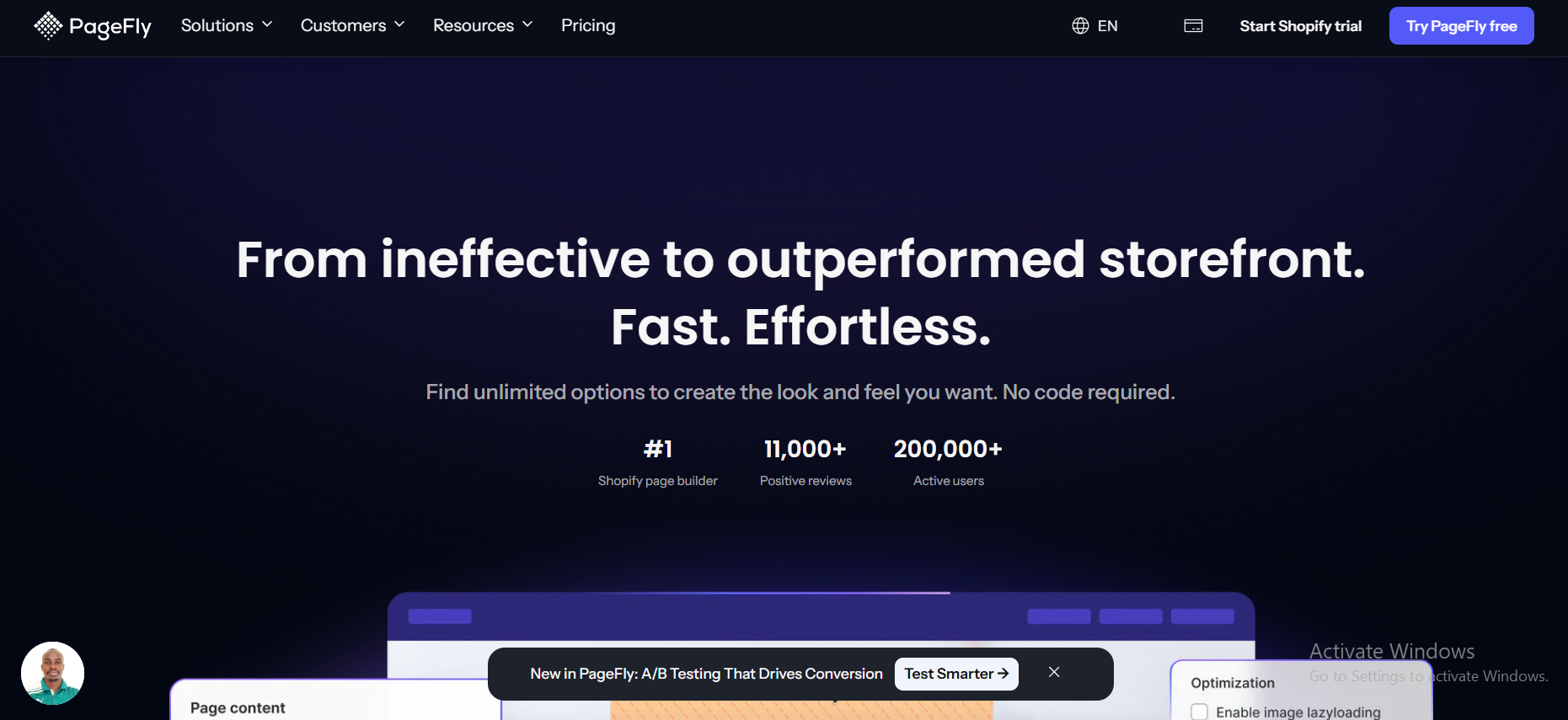
PageFly lets you create stunning custom landing pages that are designed to convert, which is crucial when selling just one product. You can tailor your home page, product page, and checkout experience exactly how you want.
Key Features:
- Drag-and-drop page builder
- 100+ high-converting templates
- Built-in SEO and speed optimizations
- Mobile-responsive designs
Why It’s Good for a One-Product Store:
Since you only have one shot to impress visitors, PageFly helps you design gorgeous, focused landing pages that guide customers smoothly from interest to purchase.
AfterShip — Logistics & Customer Notifications
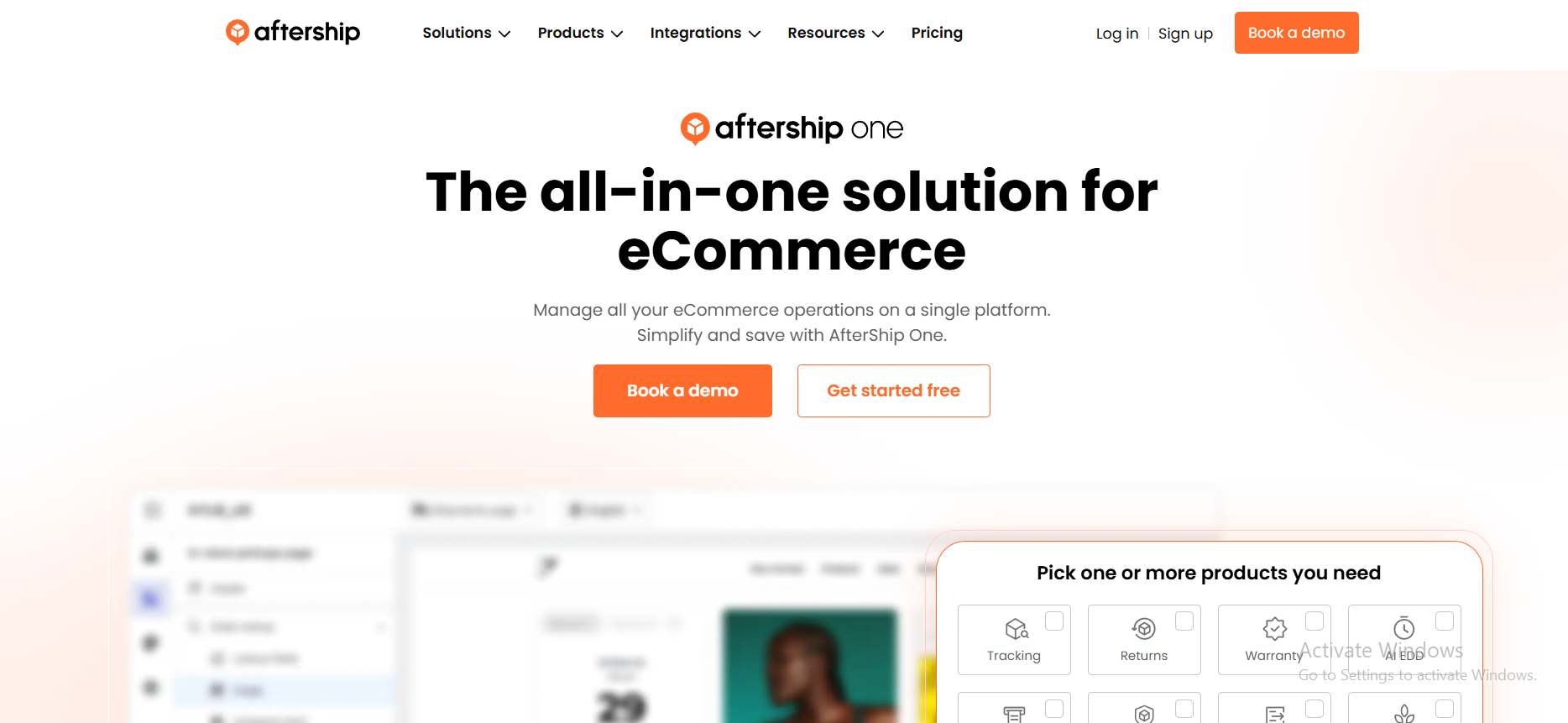
AfterShip automates shipping notifications and order tracking pages, keeping customers updated without manual work.
Key Features:
- Branded order tracking pages
- Real-time shipment updates
- Email and SMS tracking alerts
- Works with over 900 carriers
Why It’s Good for a One-Product Store:
With only one product, your reputation depends heavily on delivering a flawless customer experience. AfterShip builds trust by keeping customers informed every step of the way.
UpPromote — Affiliate Marketing Made Easy

UpPromote lets you easily set up an affiliate program to have influencers and happy customers promote your one product for you.
Key Features:
- Customizable affiliate programs
- Auto-generated referral links
- Track commissions and payouts easily
- Full Shopify integration
Why It’s Good for a One-Product Store:
Affiliate marketing is a killer growth strategy for one-product stores because it lets your community help you grow organically without massive ad spend.
Top 3 Examples Of Successful One Product Stores
1. BlendJet
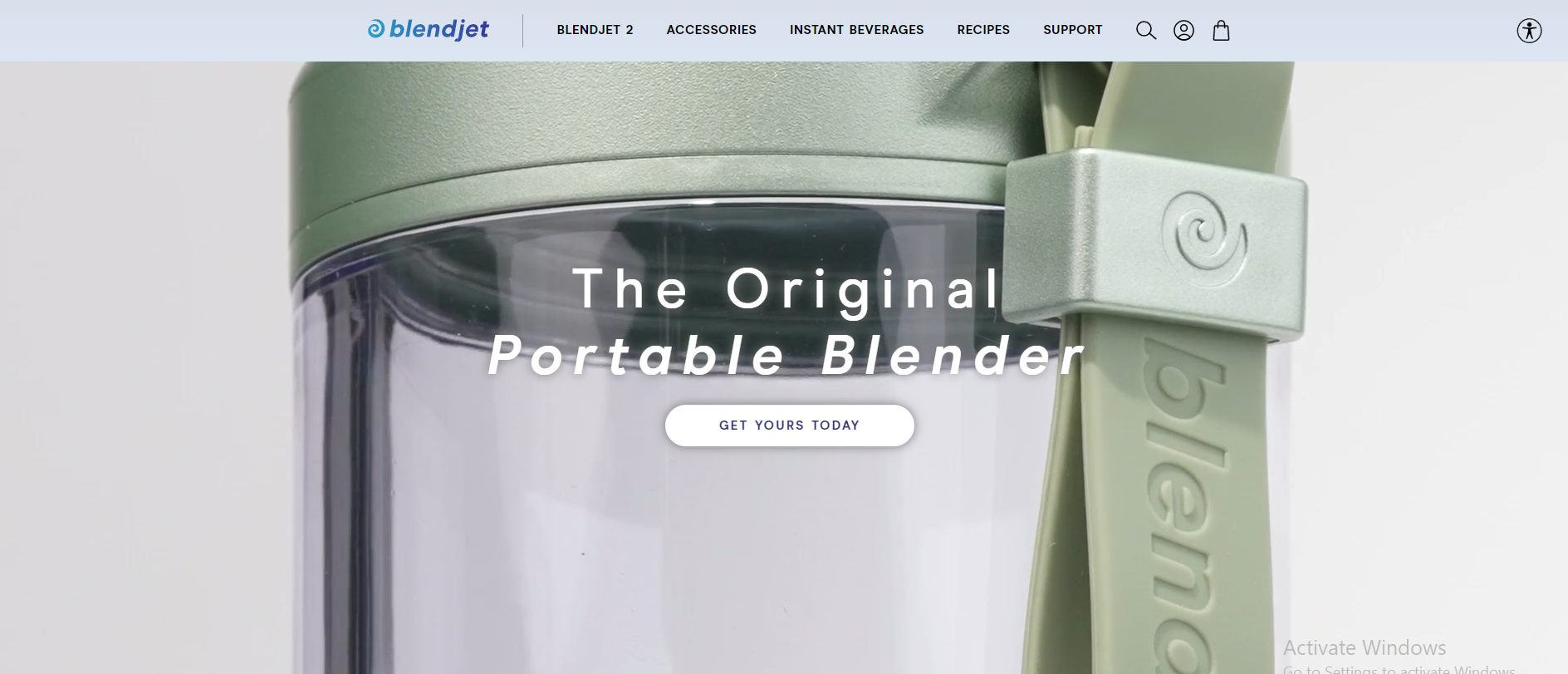
BlendJet offers a portable blender perfect for making smoothies and drinks on the go.
Their marketing revolves around vibrant visuals, influencer collaborations, and a recipe blog, all of which highlight the blender’s versatility.
BlendJet’s success comes from tapping into the health and convenience trend, making it appealing to busy, health-conscious individuals.
The store’s intuitive design, combined with user testimonials and engaging content, keeps customers interested long after their first purchase.
2. Thinx
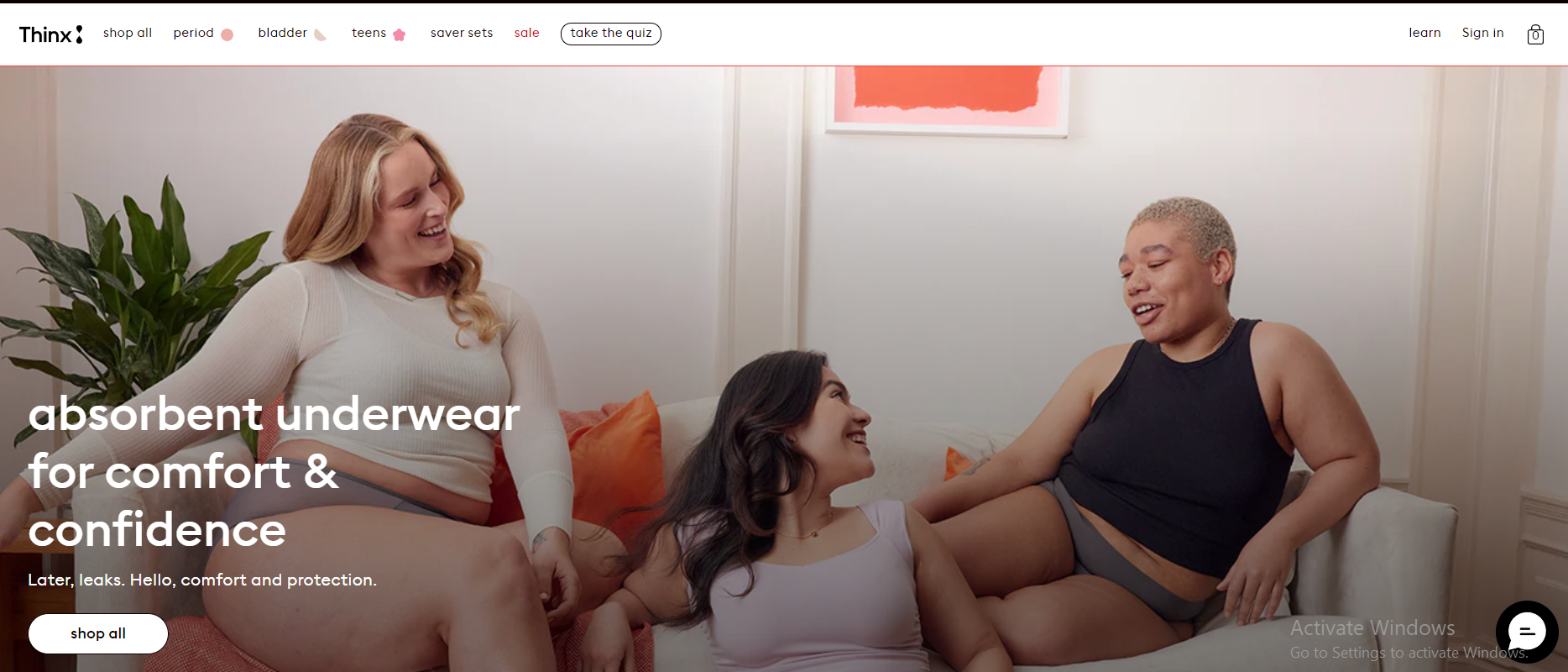
Thinx is a Shopify store offering reusable period underwear, a sustainable alternative to disposable hygiene products.
They focus on environmentally conscious shoppers by using simple, yet effective, product videos that demonstrate the underwear’s practicality.
Thinx succeeds by offering a single, high-quality product with a clean, intuitive store design.
Moreover, the use of video content and customer reviews builds trust, creating a seamless shopping experience that resonates with their audience.
3. Fybelle
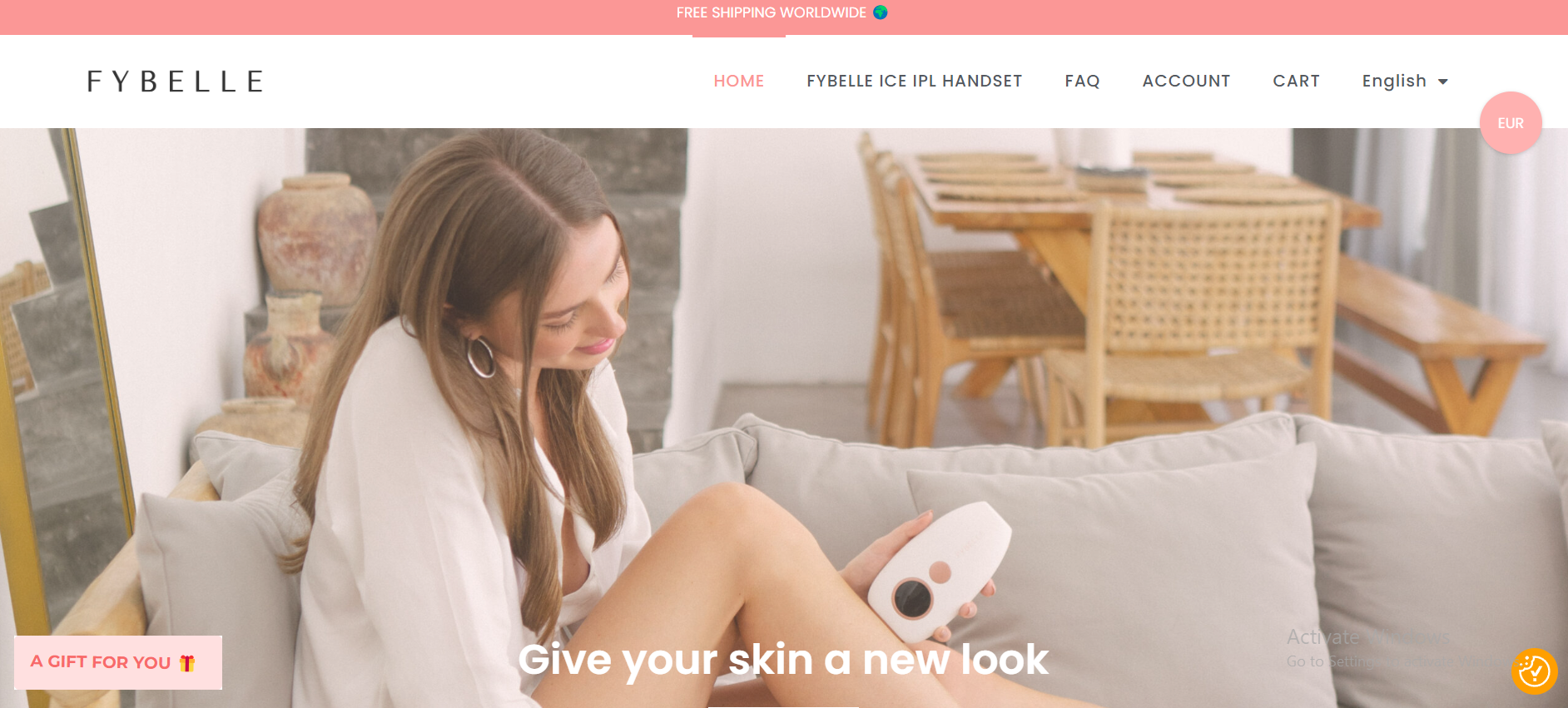
Fybelle offers an IPL hair removal device aimed at women looking for a cost-effective alternative to professional treatments.
Their feminine website design, combined with comparison charts and product videos, clearly demonstrates the product’s value and affordability.
Moreover, Fybelle’s marketing effectively targets young women by focusing on convenience and savings, which helps build trust.
Also, the simple messaging and attractive visuals further enhance the product’s appeal, making it stand out in the beauty industry.
4. Death Wish Coffee
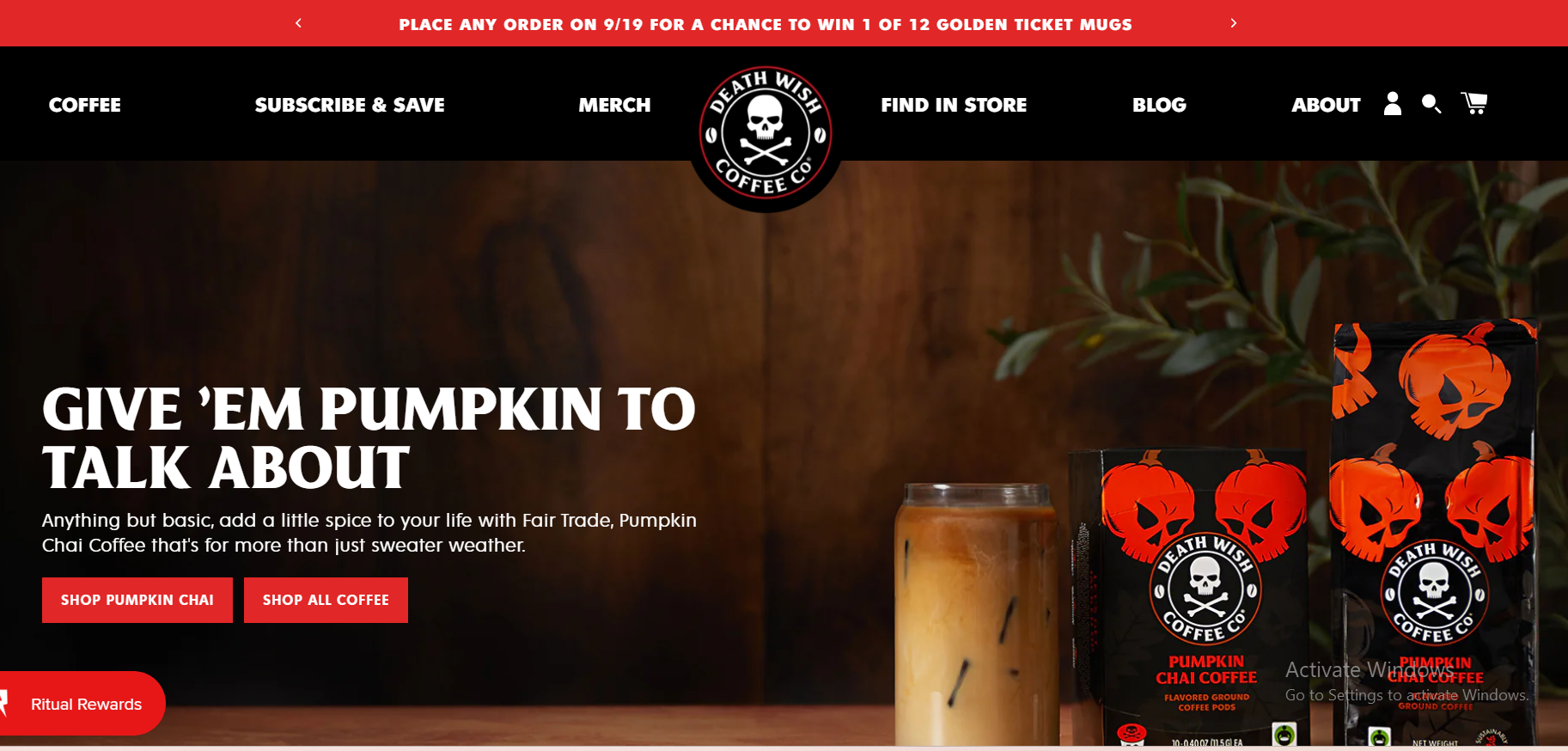
If you’re exploring the power of one product branding, Death Wish Coffee is a masterclass. Known as the store that sells “the world’s strongest coffee,” it captures attention through bold visuals, skull-themed packaging, and black-dominant aesthetics.
Their Shopify store design is fast, edgy, and built for conversions. From the moment visitors land, they see clear messaging, skull-and-bone graphics, and easy subscription options. The layout is stripped of fluff, focused entirely on converting coffee enthusiasts who crave extreme caffeine.
Their marketing strategy is aggressive yet clever. They use viral Reddit threads, email giveaways, and loyalty programs to create buzz. You’ll also notice bundled merchandise, referral incentives, and co-branded products—great ideas if you want to extend your own brand reach.
What keeps their customers coming back is consistency. Every detail of the brand—from the font choices to the packaging—screams intensity and loyalty. They lean heavily on customer reviews and testimonials as social proof, building a community around caffeine-lovers.
This store proves that nailing a single-product identity, paired with a strong subscription model, can create a cult-like following. If you’re planning your own one-product store, Death Wish Coffee is one to study closely.
5. Truff Hot Sauce
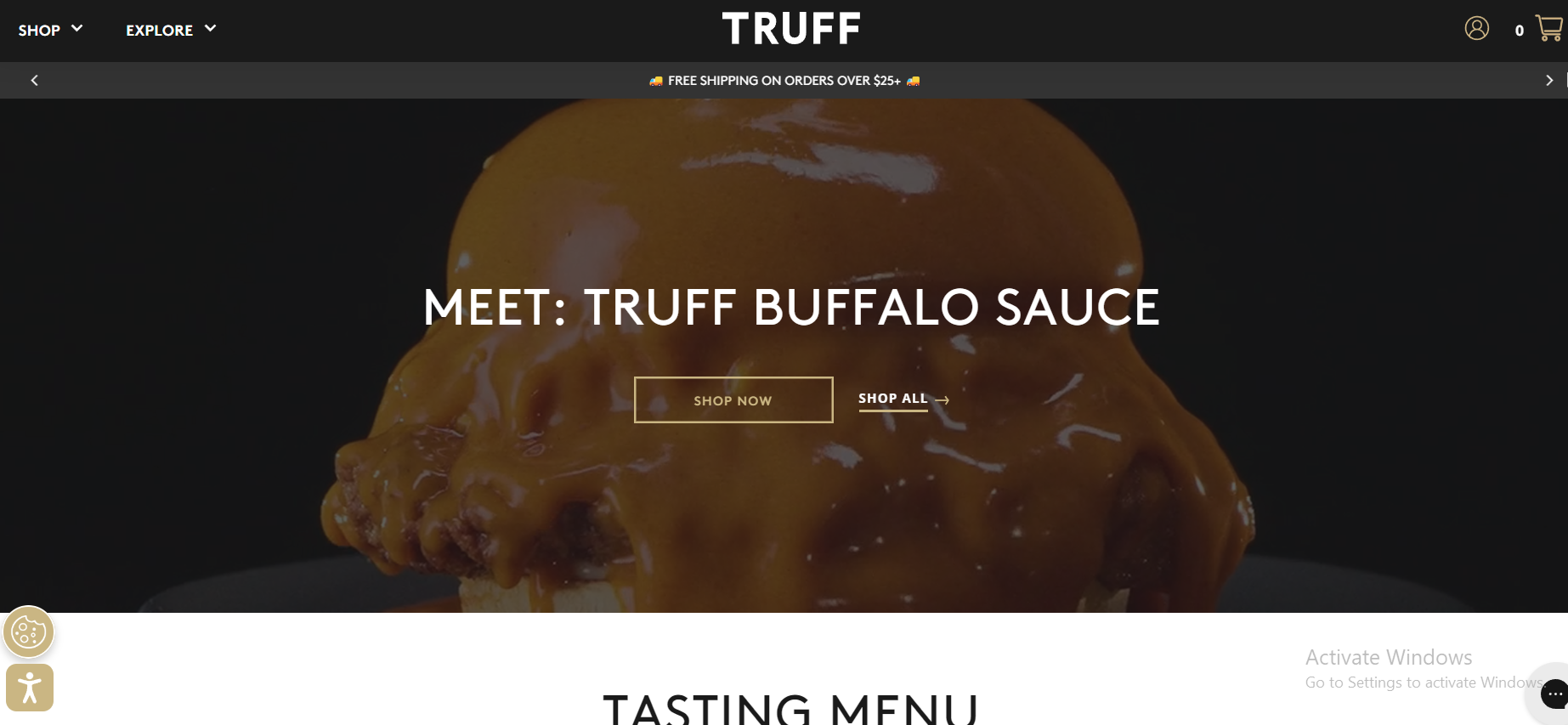
If you want to see what a luxury one-product brand looks like, Truff Hot Sauce sets the gold standard. They’ve turned truffle-infused hot sauce into a gourmet lifestyle item—and their Shopify store reflects that vision beautifully.
Everything from their black and gold palette to their hero video and product photography screams premium. The moment you land on their site, it feels like you’re browsing a high-end boutique, not just another hot sauce store.
What sets Truff apart is how they educate and engage. Their Blog + Recipes section teaches customers how to use their product across meals—from breakfast to snacks—which adds immense value and keeps shoppers coming back.
Their marketing is highly curated, leveraging chef influencers, luxury collabs, and features in gourmet gift guides. Social proof comes in the form of thousands of glowing reviews displayed across the site, making trust-building effortless.
Some standout features include gift box bundles, exclusive limited drops, and a Shopify layout that enhances the product’s perceived value. With over 106K monthly visitors, they’ve crafted a brand that thrives on gifting moments, loyalty, and taste.
If your goal is to sell one premium product with a strong identity and high retention, Truff is a top-tier blueprint to follow.
Top 5 Products To Dropship When Starting Out in 2025
1. Smart AI Posture Correctors
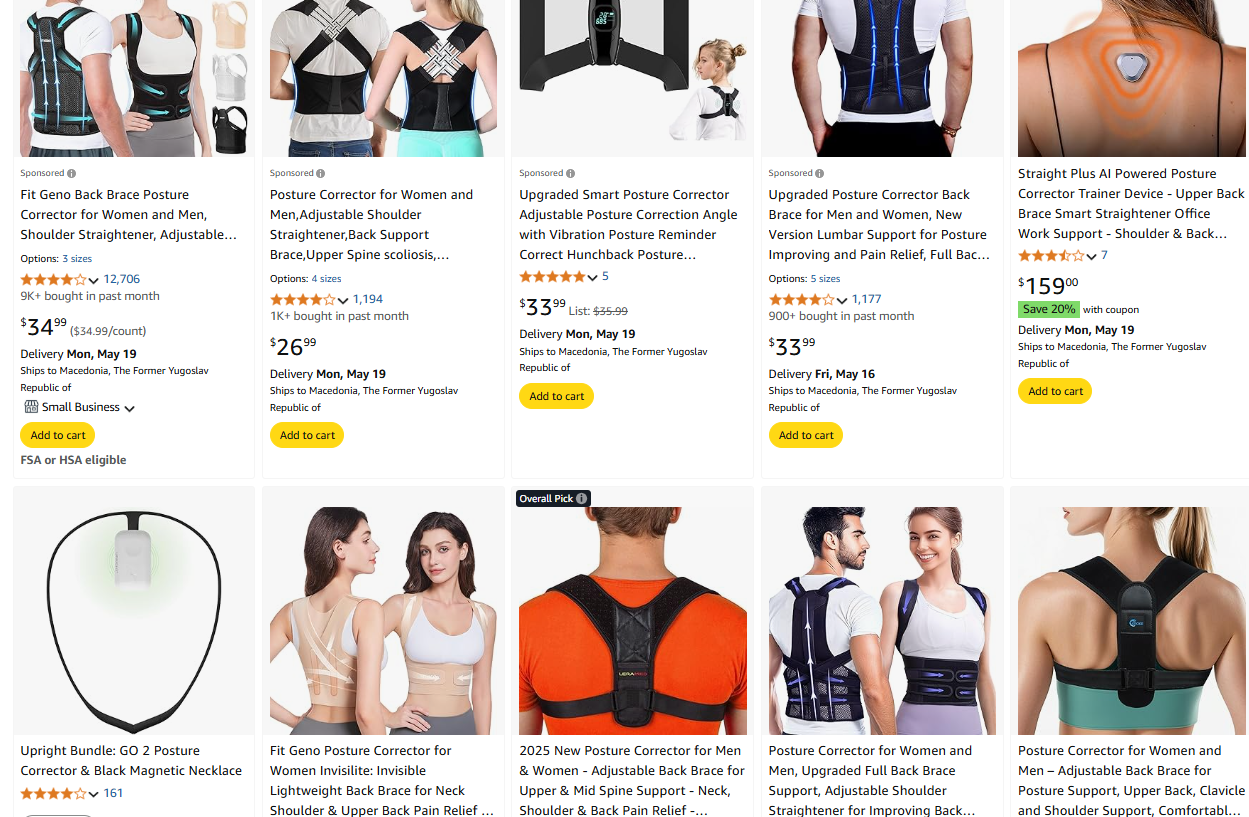
In today’s digital age, many people spend hours hunched over screens, leading to poor posture and associated health issues.
Smart AI posture correctors are wearable devices that gently vibrate to remind users to straighten up, promoting better posture habits over time.
Why it’s a great product:
- Target Audience: Office workers, students, gamers, and anyone spending extended periods sitting.
- Sourcing Cost: Approximately $6–$11.
- Retail Price: Around $60–$70.
- Profit Margin: Approximately 50–70%.
- Market Trend: The global posture correction market was valued at $1.4 billion in 2024 and is projected to grow at a CAGR of 7.6% from 2025 to 2034, indicating a growing demand for such products.
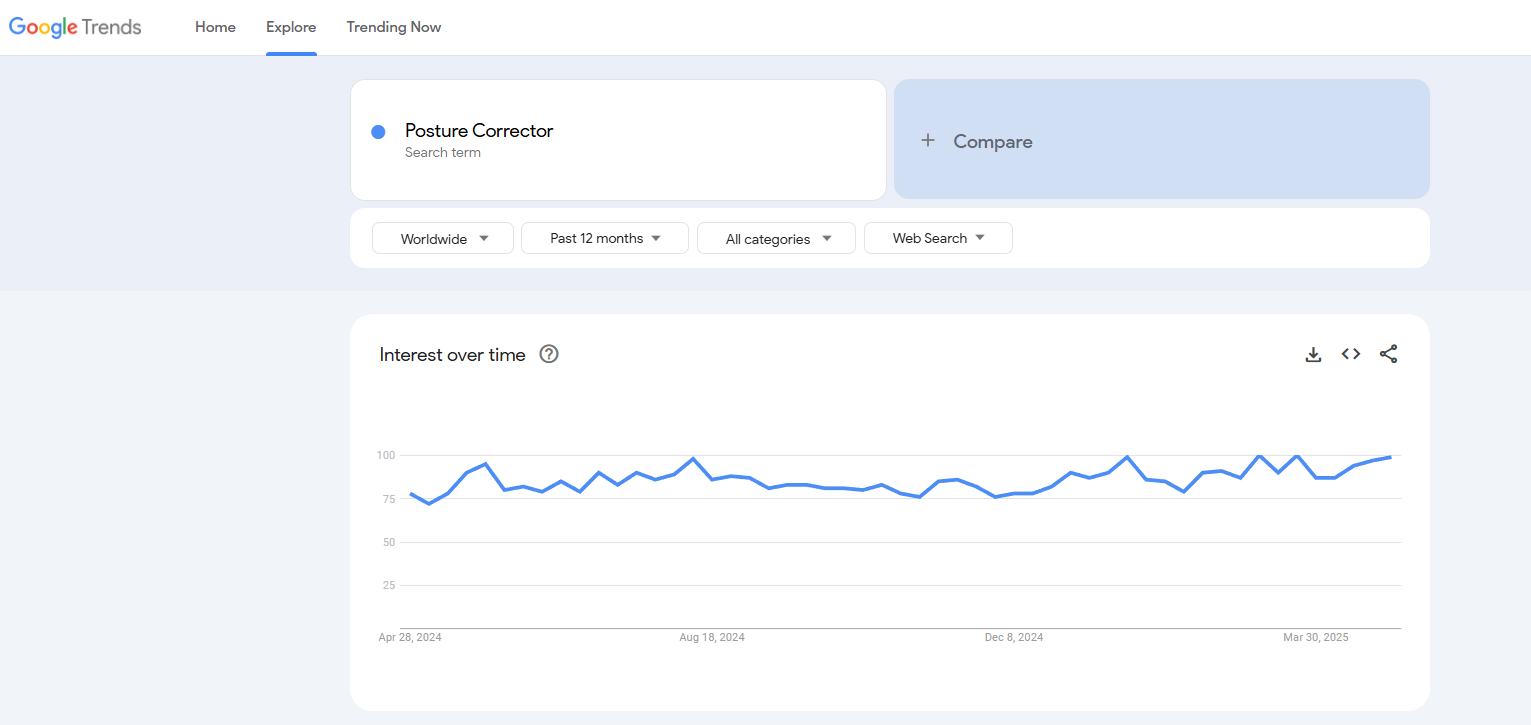
2. Smart Pet Feeders
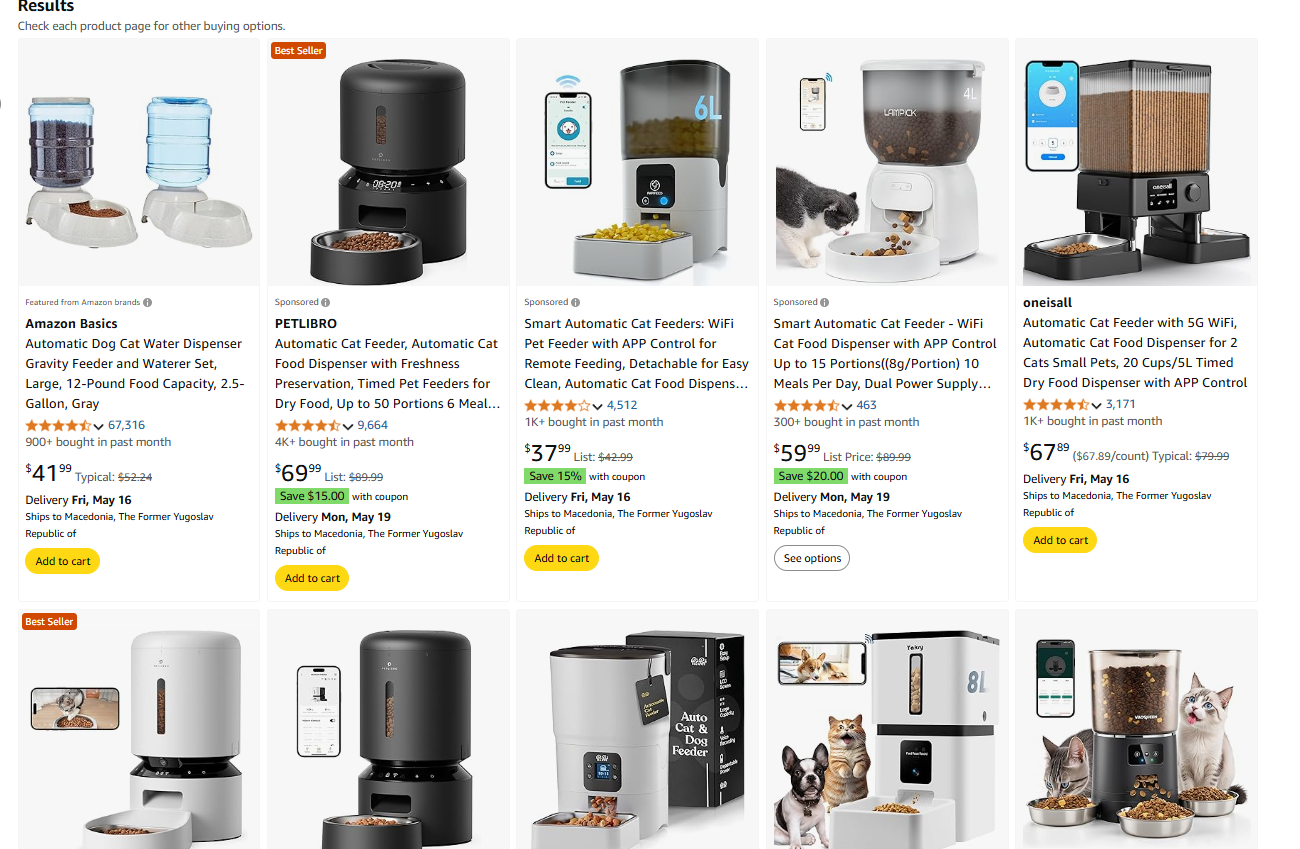
Pet ownership has surged, and with busy lifestyles, pet owners are seeking convenient solutions to care for their furry friends.
Smart pet feeders allow owners to schedule feedings, control portions, and even monitor their pets remotely via smartphone apps.
Why it’s a great product:
- Target Audience: Pet owners, especially those with busy schedules or who travel frequently.
- Sourcing Cost: Approximately $30–$50.
- Retail Price: Around $80–$120.
- Profit Margin: Approximately 50–60%.
- Market Trend: The global smart pet feeder market is expected to reach $2.35 billion by 2030, expanding at a CAGR of 8.46% from 2025 to 2030.
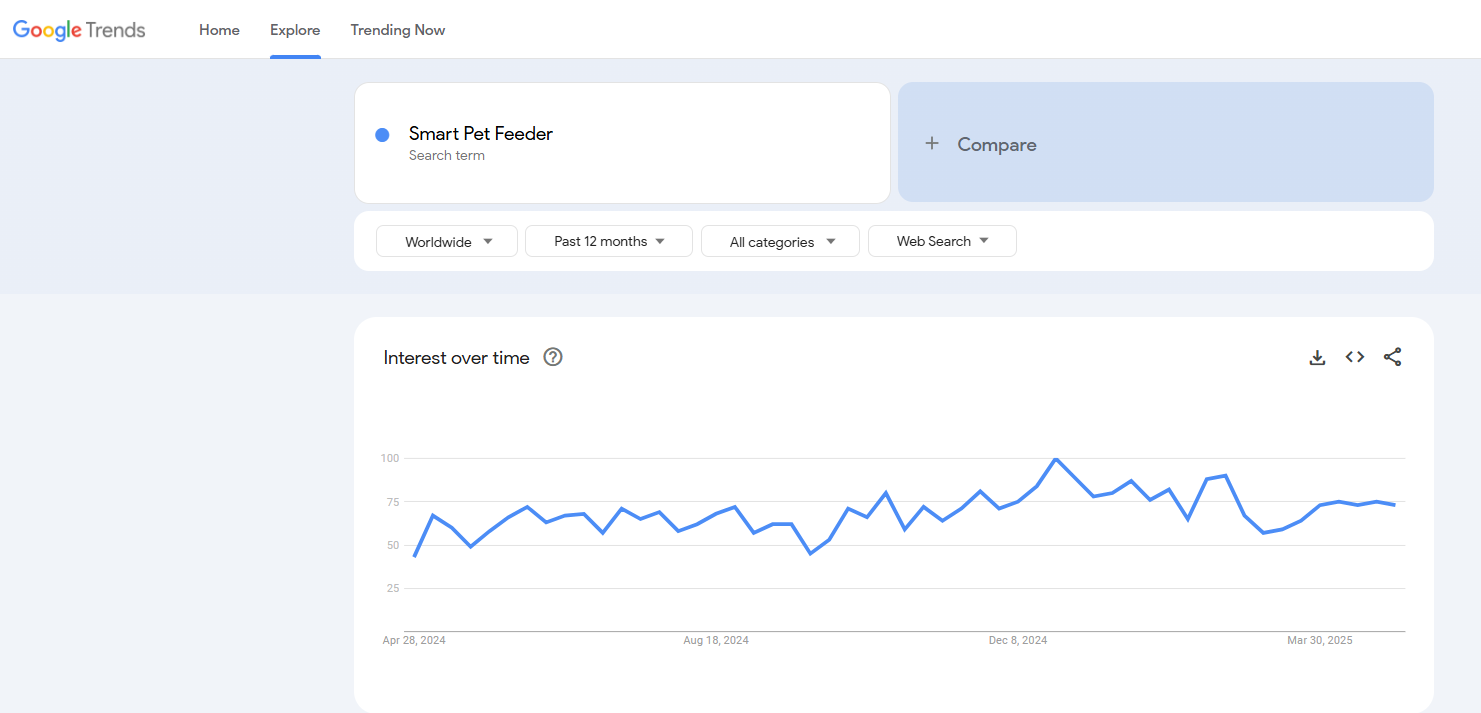
3. Mini Robot Vacuums
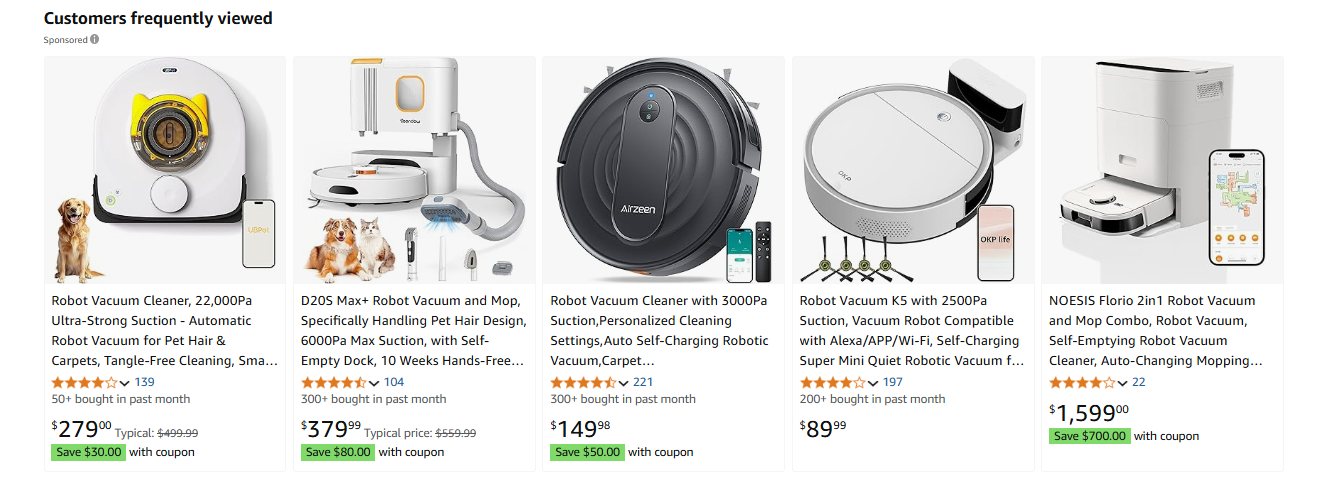
As smart home technology becomes more accessible, mini robot vacuums are gaining popularity. These compact devices efficiently clean floors, navigating around obstacles and returning to their charging stations autonomously.
Why it’s a great product:
- Target Audience: Homeowners, apartment dwellers, and tech enthusiasts.
- Sourcing Cost: Approximately $80–$150.
- Retail Price: Around $200–$300.
- Profit Margin: Approximately 50–60%.
- Market Trend: The robotic vacuum cleaners market is expected to grow from $9.37 billion in 2024 to $11.14 billion in 2025 at a CAGR of 18.8%

4. Reusable Beeswax Food Wraps
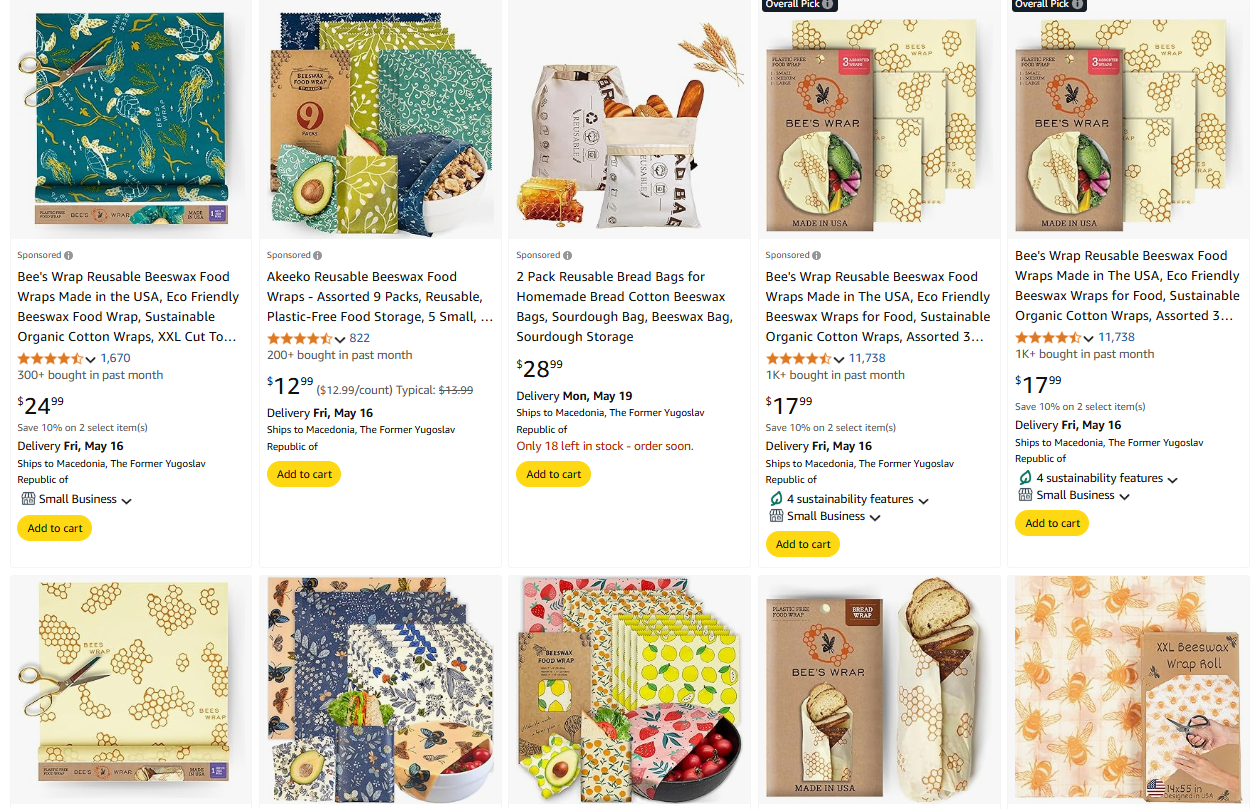
With increasing environmental awareness, consumers are seeking sustainable alternatives to single-use plastics. Reusable beeswax food wraps offer an eco-friendly solution for food storage, reducing plastic waste.
Why it’s a great product:
- Target Audience: Eco-conscious consumers, families, and zero-waste advocates.
- Sourcing Cost: Approximately $3–$6 per set.
- Retail Price: Around $15–$25 per set.
- Profit Margin: Approximately 60–70%.
- Market Trend: The global beeswax wrap market is projected to reach $1.5 billion by 2033, growing at a CAGR of 12% from 2025 to 2033.
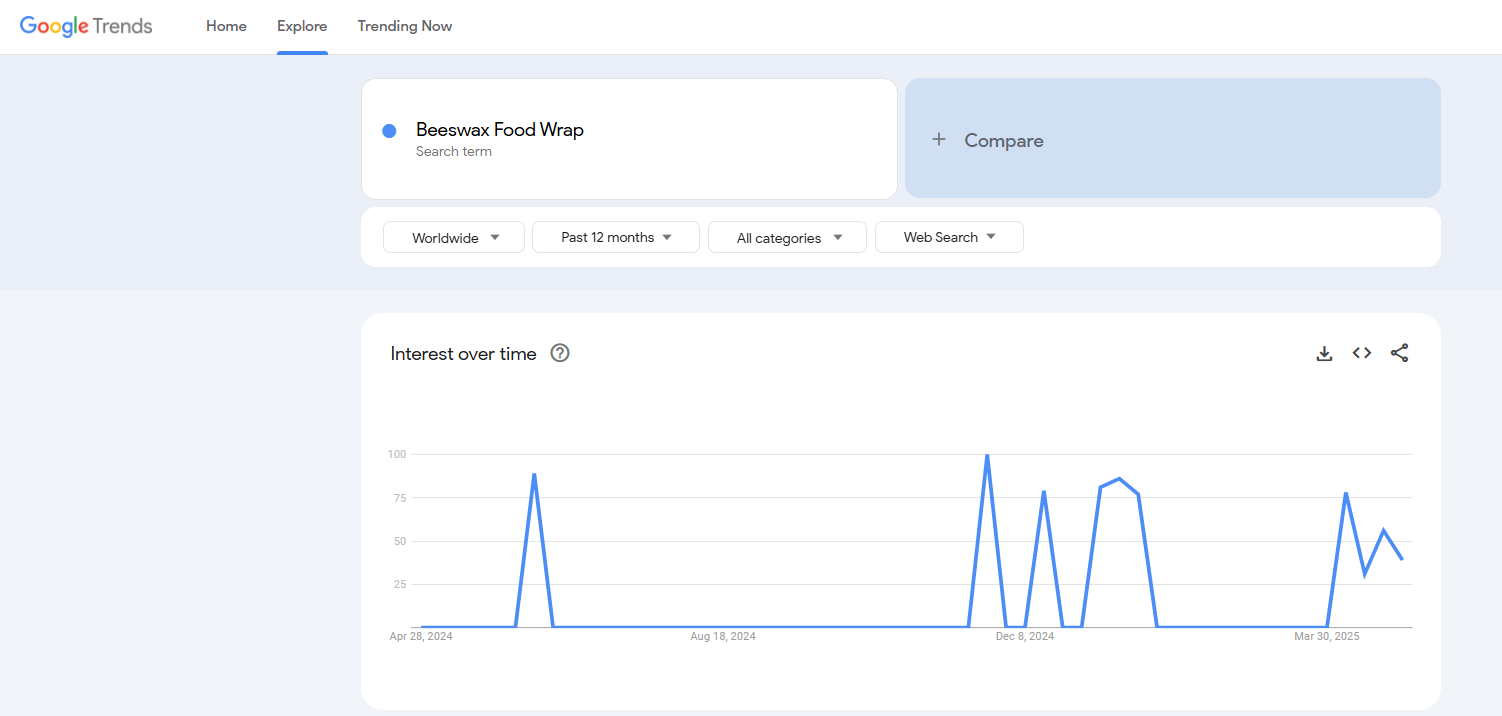
5. Kinetic Desk Toys
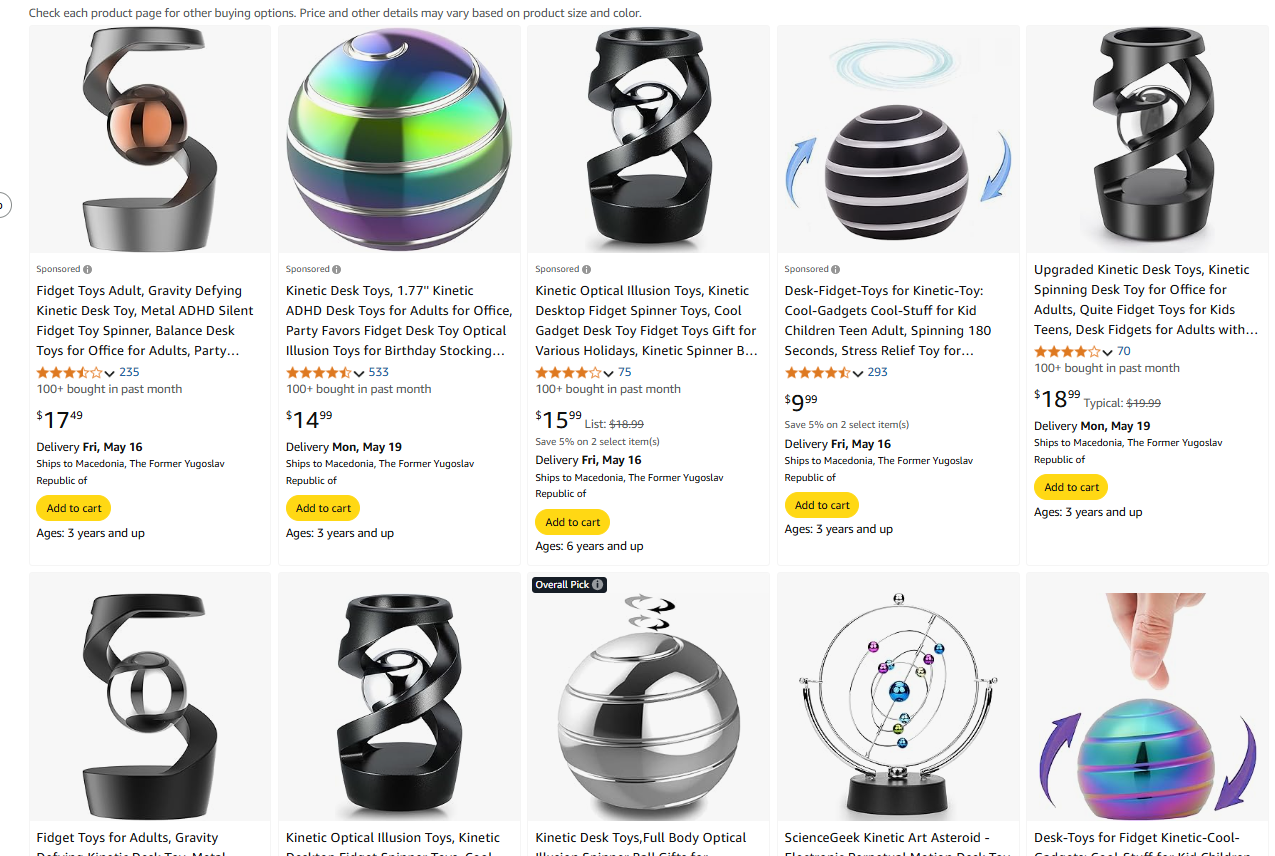
In an era where mental well-being is prioritized, kinetic desk toys serve as both stress relievers and conversation starters. Their mesmerizing movements can help improve focus and provide a calming effect during work or study sessions.
Why it’s a great product:
- Target Audience: Office workers, students, and individuals seeking stress relief.
- Sourcing Cost: Approximately $10–$20.
- Retail Price: Around $30–$60.
- Profit Margin: Approximately 50–60%.
- Market Trend: The global decompression toy market, which includes kinetic desk toys, is projected to reach $5.01 billion by 2035, growing at a CAGR of 5.1% from 2025.
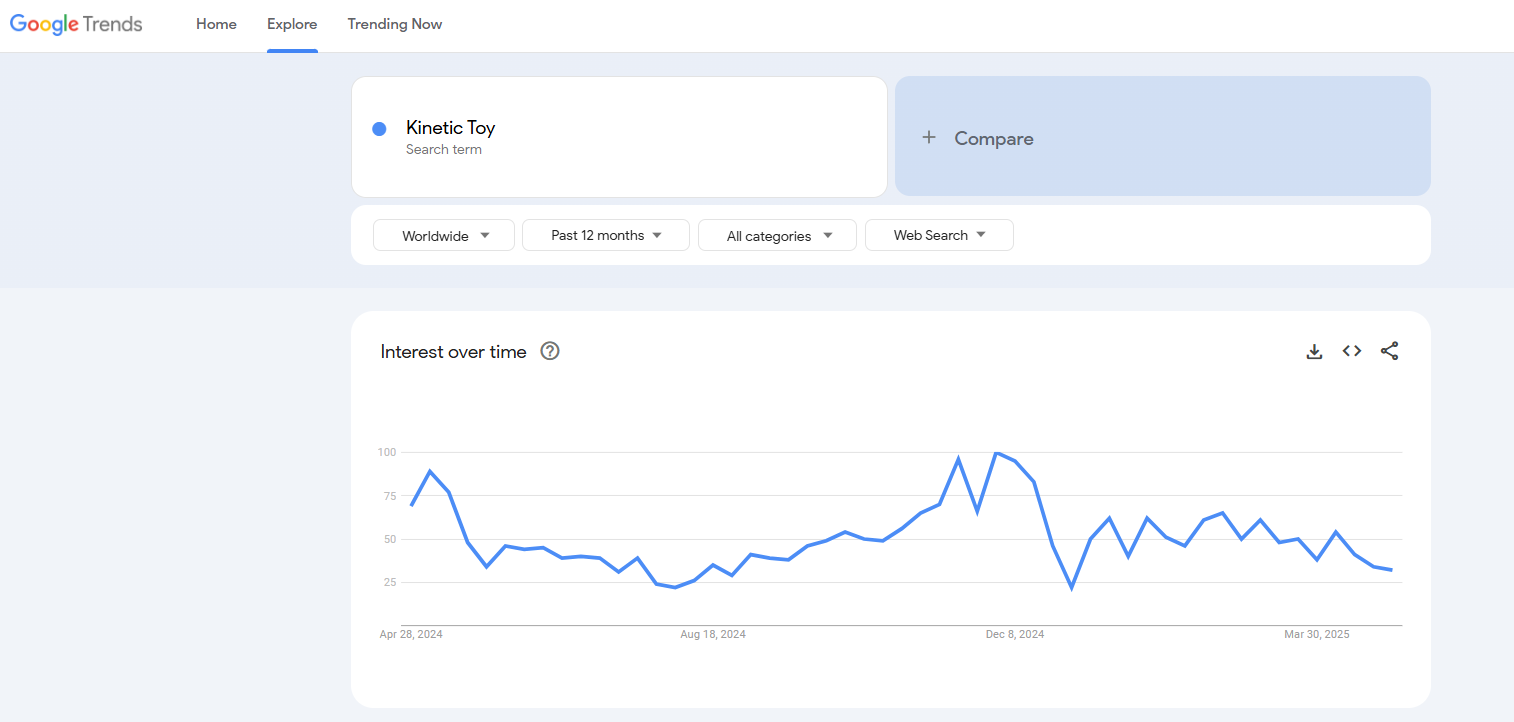
FAQs- How Many Products Should I Start With When Dropshipping?
Is There an Ideal Number of Products to Start With When Dropshipping?
Why Is It Important to Limit the Number of Products Initially?
Should I Focus on a Niche or Offer a Variety of Products?
How Do I Choose the Right Products for My Dropshipping Store?
Is It Better to Test a Few Products or Launch a Wide Range from the Beginning?
What Impact Does the Number of Products Have on Website Design and User Experience?
How Can I Scale My Product Range Over Time?
What Tools Can Help Manage a Larger Product Inventory Efficiently?
How Often Should I Update My Product Offerings?
What Role Does Marketing Play in the Success of a Dropshipping Store With a Limited Product Range?
🚀 Mini Case Study: How Choosing the Right Number of Products Helped Mark Scale His Dropshipping Store Fast
When Mark first launched his Shopify store in early 2024, he wasn’t sure how many products he should start with for dropshipping. Like many beginners, he assumed the more products, the better — so he listed over 120 items across random categories.
The result?
Confused customers, no clear brand identity, and sky-high ad costs. His first $500 in Facebook ads brought only three small sales. It became obvious that his dropshipping product selection strategy needed a serious rethink.
After researching the best number of products to start dropshipping, Mark decided to pivot. He narrowed his store down to just 18 carefully selected products, all targeting eco-friendly home goods — a niche he personally loved.
He focused heavily on high-demand, low-competition products like reusable beeswax wraps and smart home organizers. His ad creatives became more consistent. His branding felt sharper. And most importantly — his cost per purchase dropped by 45% within the next 30 days.
Mark’s success proved that starting with fewer, better-matched products creates a faster, clearer path to sales.
Today, his store generates $12,000+ per month, and he still operates with just 25 products total — proving that you don’t need hundreds of items to build a profitable dropshipping business.
✅ The Key Point:
If you’re wondering how many products for dropshipping is ideal, starting with 10–20 highly targeted products gives you the best chance to build momentum, optimize your ads, and create a real brand — without feeling overwhelmed.
Conclusion
Choosing how many products to start with when dropshipping is one of the most important decisions that shapes your store’s success. Whether you’re building a general store, niche store, or one-product brand, the right product strategy makes all the difference.
Here are the key takeaways to remember:
✅ Start Lean and Focused:
The best number of products to start dropshipping is usually between 10 to 20 carefully selected items for most stores. It gives you the breathing room to test, optimize, and build strong marketing without feeling overwhelmed.
✅ Match Your Store Type:
- For a general store, start with 20–50 products spread across a few trending categories.
- For a niche store, start with 5–20 specialized products that deeply serve a passionate audience.
- For a one-product store, focus on 1 hero product with a couple of smart upsells.
✅ Prioritize Quality Over Quantity:
A smaller, well-curated catalog beats a bloated one every time. Customers today expect expertise, trust, and fast decision-making — not endless scrolling. Your dropshipping product selection strategy should reflect this.
✅ Use a Step-By-Step Expansion Plan:
As you grow, add 1–3 new products every 4–6 weeks based on real sales data and customer feedback, not random guessing. This method keeps your store fresh without overwhelming your operations.
✅ Remember the Customer’s Perspective:
Too many options can confuse and slow down buying decisions. Focus on offering solutions, not just filling up your catalog.
🚀 Whether you’re starting with 5, 15, or 50 products, the real key is launching smart, optimizing fast, and scaling based on proven winners, not assumptions.
If you’re still wondering how many products for dropshipping fit your exact business model, ask yourself:
➡️ “Can I market and manage these products at the highest possible quality right now?”
That’s your true starting point.
Now you’re ready to build a store that’s focused, profitable, and built for growth in 2025 and beyond! 🌟













![The Top 21 3PL Companies Compared [2025 List & Guide]](https://images.weserv.nl/?url=https://prod-dropshipping-s3.s3.fr-par.scw.cloud/2024/03/Frame-3922469.jpg&w=420&q=90&output=webp)